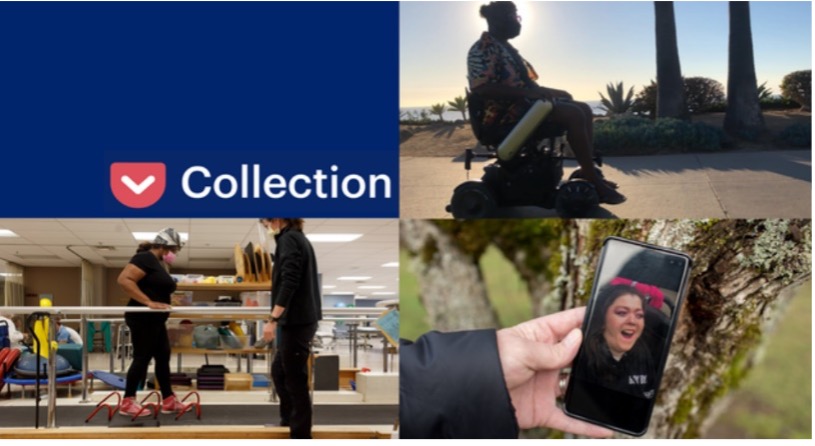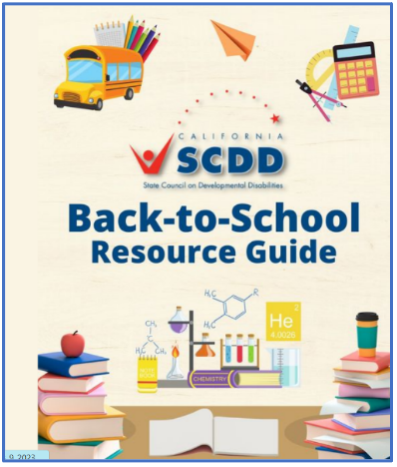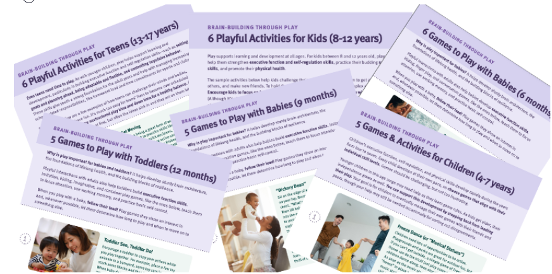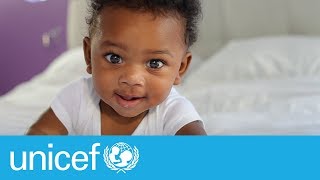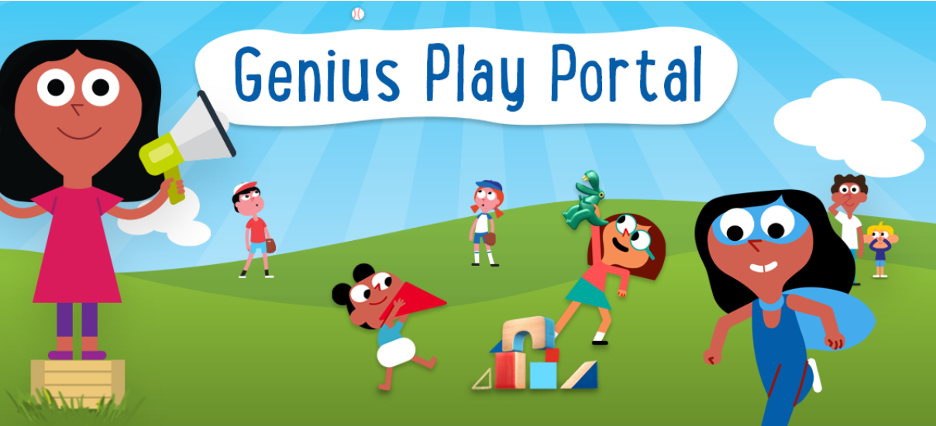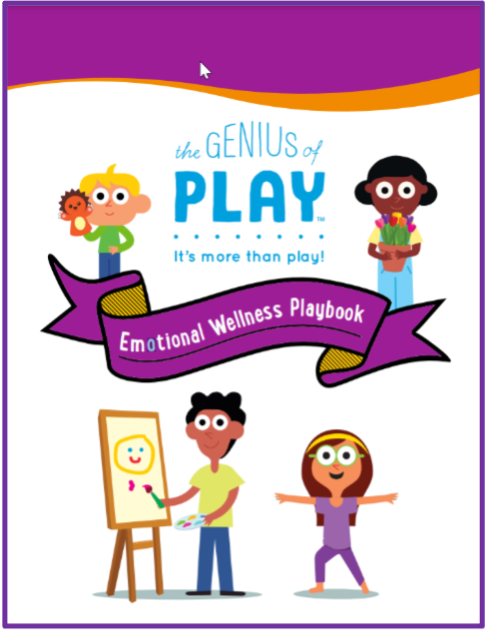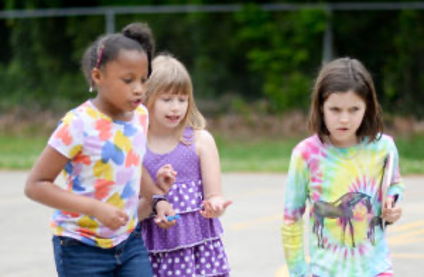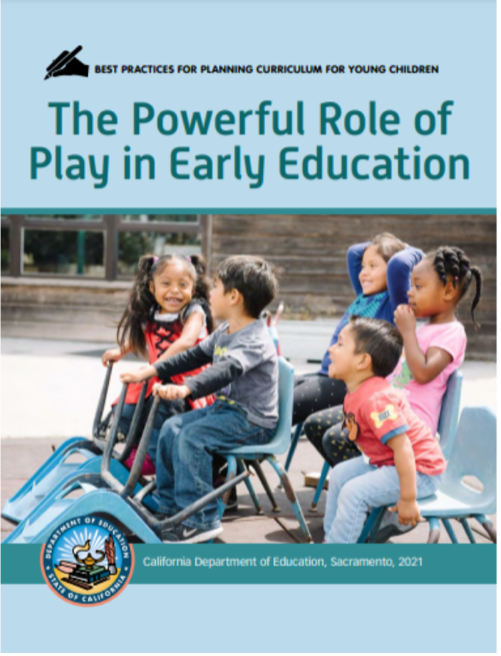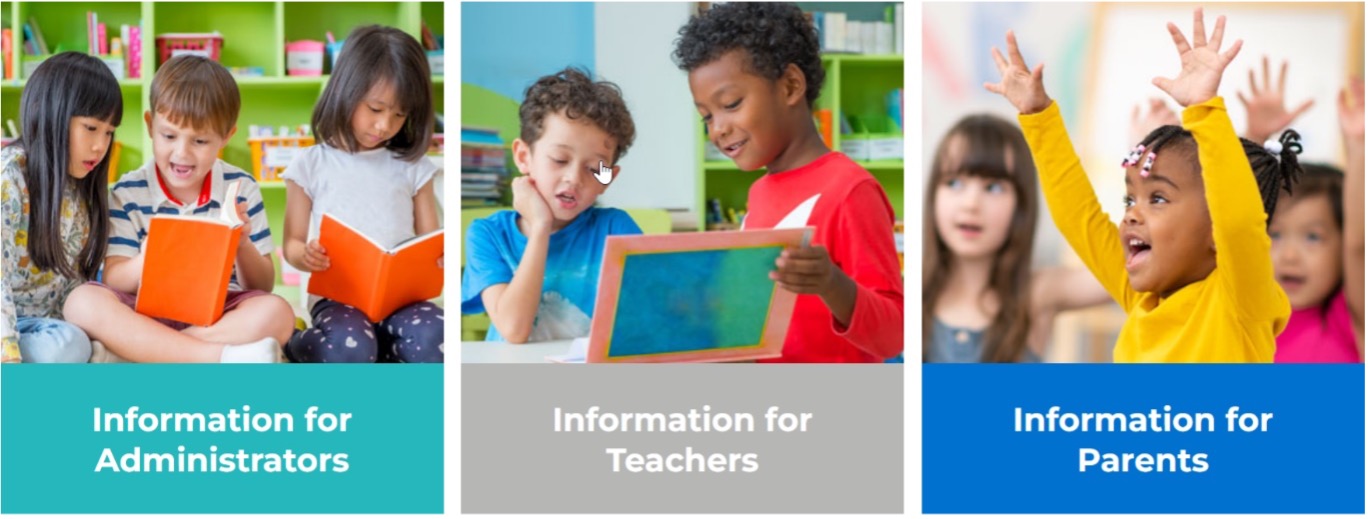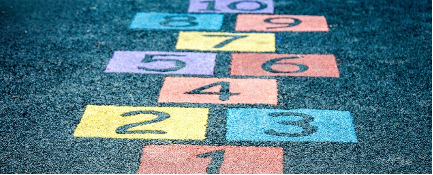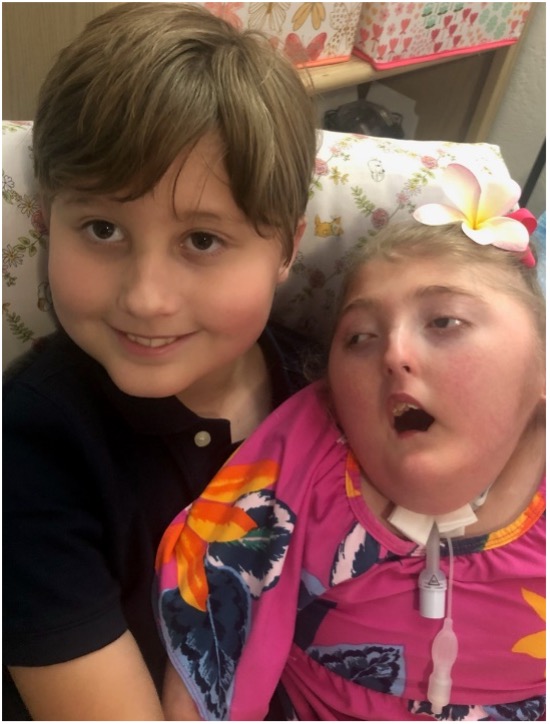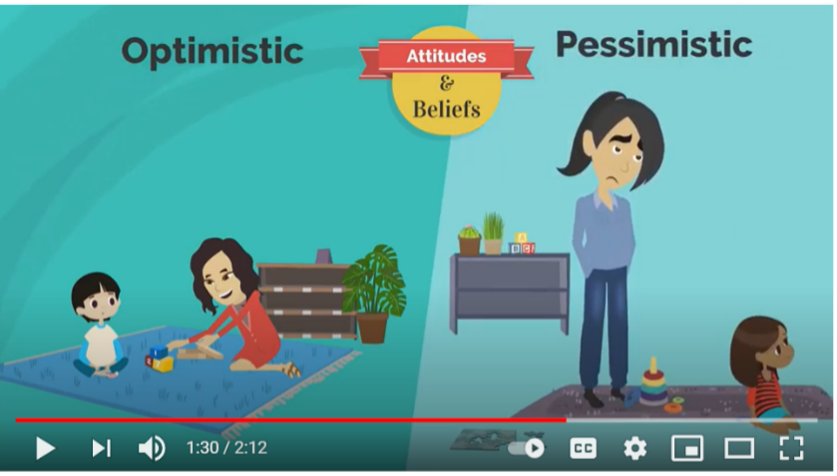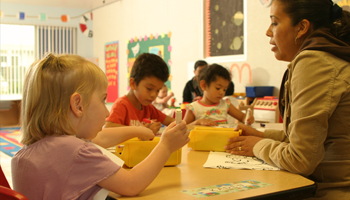Links to information, tools, websites and other resources that support the development, management and sustainability of inclusive practices in early care and education settings are found in this area.
#10-Inclusion Makes a Difference (Video)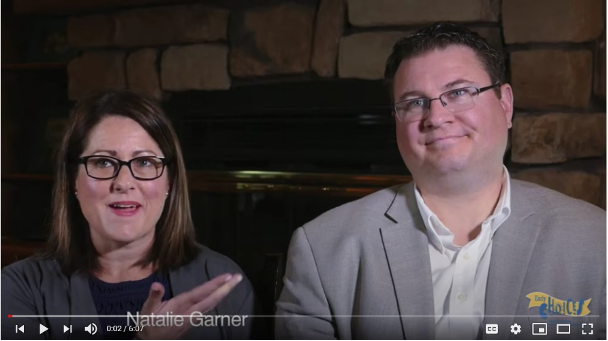
Early Choices | June 6, 2018 | Length: 6:08 minsMom and dad talk about how inclusion of their son with Down’s Syndrome had made a difference for their family and other kids and families. This is an emotional testimony about the benefits of inclusion for everyone in the community.
Added: Feb 2021
11 Things to Do After an IEP MeetingBrookes Publishing | May 2023Many critical decisions are made during an IEP meeting for a student with support needs, so effective and timely followup—with families, students, and other team members—is essential. Today’s post offers a checklist of to-do items to follow after the meeting is over. Excerpted and adapted from Equitable and Inclusive IEPs for Students with Complex Support Needs by Andrea L. Ruppar & Jennifer A. Kurth, these action items will help you follow up successfully, ensure there’s a plan for implementing the IEP, and start the team on a path to success.
See also 4 Barriers and Solutions to Family Participation in IEPs
Added: Jun 2023
2023-2024 Calendar of Activities Free From Brooke’s Publishing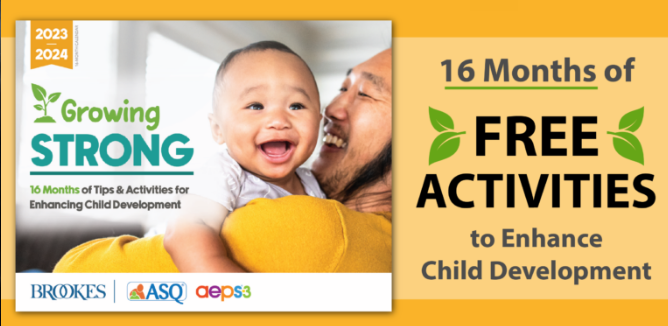
Brookes Publishing | 2023Brooke’s Publishing is offering a new FREE early childhood resource that can help you keep track of your busy schedule and promote healthy development at the same time. The brand-new Growing Strong calendar is filled with 16 months—from September 2023 through December 2024—of colorful photos, memorable quotes from our authors, and practical tips and activities. Print one out for yourself, colleagues, and anyone who cares for young children, so they can help support key skills all year long!
Added: Sep 2023
21 Chrome Extensions for Struggling Students and Special Needs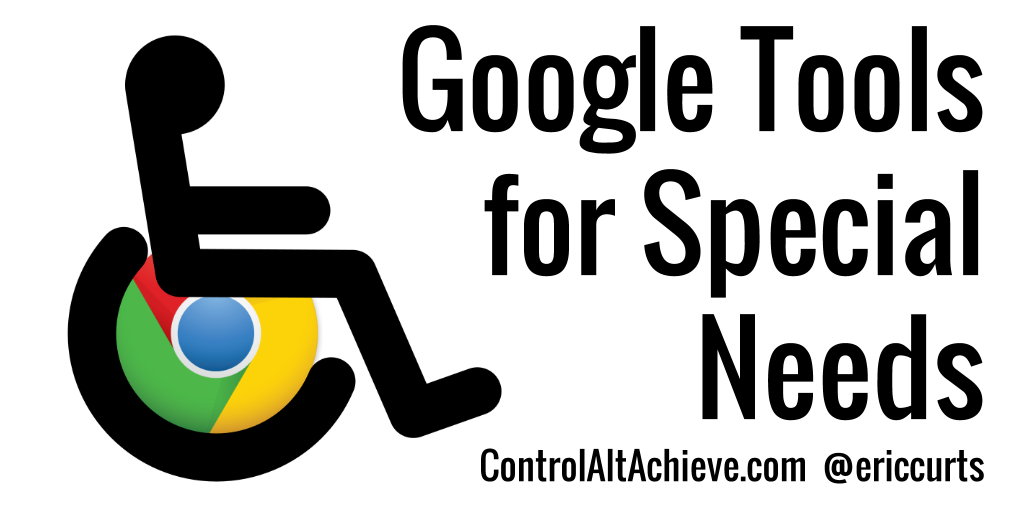
Technology can be a powerful tool to assist students with special needs or any sort of learning challenge. In particular the Chrome web browser allows users to install a wide variety of web extensions that provide tools that can help all learners, regardless of ability level.
Added: Nov 2016 | Updated: Feb 2019
26 Things You Can Do To Create More Inclusive School Spaces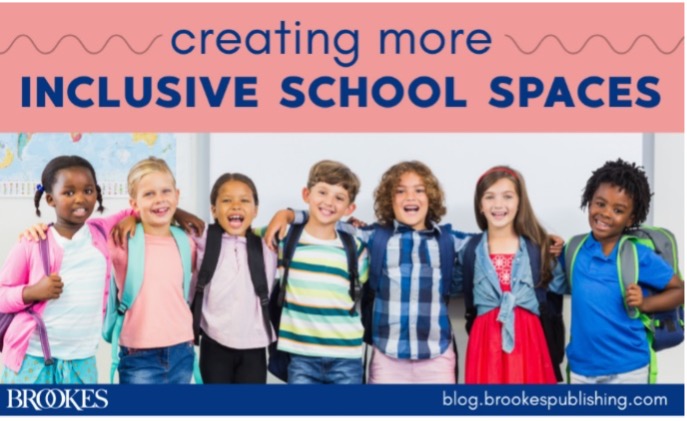
Brookes Publishing | November 16, 2021“Inclusive school spaces are a physical, tangible reflection of the belief system that the school community holds. Classrooms, libraries, auditoriums, and playgrounds are responsive to the students’ interests and needs by using a multitude of ways to physically facilitate feelings of inclusion and belonging. Inclusive spaces also promote opportunities for cognitive, social, emotional, and physical growth and are designed with the diverse cultures and languages of students in mind.” Nicole Eredics
Added: Mar 2022
3 Myths of “Special Education”-Thoughts for Parents
Published: 2018 | Catia Malaquias, StartingWithJulius.org.au
When decades of evidence have shown that segregated education disadvantages students with disability by producing inferior academic and social outcomes in a “low expectations” environment, then it is fair to say that the ‘choice’ of parents to segregate their children in a very real sense can be “disabling” in itself. The failure of Governments and professionals to better guide parents in their decision-making is unconscionable – even negligent.
Added: Jul 2019 | Updated: Jun 2020
A Guide to Itinerant Early Childhood Special Education Services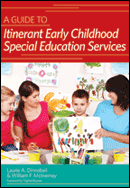
Brookes Publishing | 2011A much-needed book that provides the knowledge and guidance itinerant teachers need to integrate learning opportunities into daily routines and activities in order to support children's inclusion in community-based programs.
Added: Oct 2021
A Summer Guide to Inclusive Play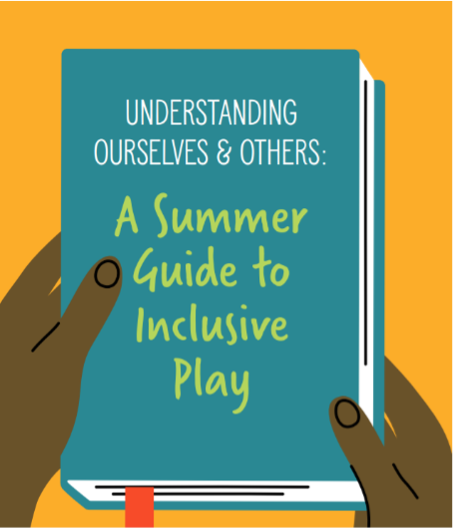
Inclusive Schools NetworkThe Inclusive Schools Network, in collaboration with Finding My Way Books and Changing Perspectives, is pleased to share Understanding Ourselves and Others: A Summer Guide to Inclusive Play. Designed for K-8 students, the guide provides parents, caregivers, camp counselors, and others with strategies and activities to build student confidence and encourage belonging during the summer months.
Although opportunities to develop the essential skills of empathy, self-awareness, confidence, and inclusion are present every day, the summer hiatus from school offers unique possibilities for students to travel, attend camps, connect with kids from other schools, and engage socially in more unstructured ways than during the scheduled academic year. It is a prime time to nurture our young people to become confident, inclusive changemakers for tomorrow.
This guide provides books, tools and activities that help parents and care providers facilitate interactions, empathy and inclusion between children with and without disabilities. It includes recommendations for children’s books that normalize disability and includes tools to help emphasize similarities between children and characters in books or in real life. Everyone who want to promote friendships and inclusion will find something useful and inspirational in this Guide.
Added: Jul 2022
Accessible Design vs Inclusive Design (with Infographic)Stepping away from preconceived notions about “typical” users through an inclusive design process allows designers to create digital products that are user-friendly to the widest range of people. This article helps you to understand the difference between “accessible design and inclusive design” and gives you a downloadable infographic that brings the explanation to life!
Added: Oct 2021
Achieving Inclusion: What Every Parent Should Know When Advocating for Their Child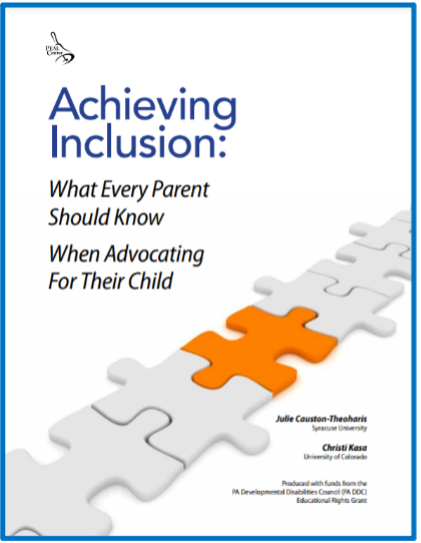
Julie Causton and Krista Kasa, Inclusive SchoolsInclusion is a legally-supported, evidence-based practice that continues to show positive outcomes for students with and without disabilities in schools. Where a child is educated is one of the most important educational decisions a team can make. Parents are an essential component of that team.
This 16 page guide provides an introduction to inclusion for families. Ideas presented here help parents to articulate a clear vision and work in collaboration with their school team to advocate for their child to successfully achieve meaningful inclusion. It explores questions that parents frequently have about inclusion and provides guidance for how parents can be an effective member of the IEP Team supporting inclusion. More resources on inclusion for parents can be found on the Inclusive Schooling website including a Checklist of Sample Supports, Aids and Services (PDF)
Added: Jul 2022
Administration for Children and Families (ACF)The Administration for Children and Families (ACF) is a division of the Department of Health & Human Services. We promote the economic and social well-being of families, children, individuals and communities.
- Birth to 5: Help Me Thrive Initiative of the US Department of Health and Human Services
This initiative draws heavily on previous developmental and behavioral screening efforts by consolidating materials from a wide array of federal agencies and their non-federal partners. As part of this initiative, they have published a compendium of research-based developmental screening tools appropriate for use across a wide range of settings and tailored guides for use with the screening tools geared toward nine different audiences including early care and education providers, early intervention providers, home visitors and families. The guides address the importance of developmental and behavioral screening, how to talk to parents, where to go for help, and how to select the most appropriate screening tool for the population served as well as the provider implementing the screening.
- Tips for Early Care and Education Providers: Simple Concepts to Embed in Everyday Routines (PDF)
Researchers from around the country offer helpful tips that you can practice to help the young children in your care grow and learn. The tips are based on concepts of learning and development that can be worked into everyday routines. Each tip describes a concept, why the concept is important, and a step-by-step description of how to put the concept into action. We hope these concepts are useful in supporting all the children in your care.
- Autism Awareness and Acceptance in Early Childhood Education
Autism Spectrum Disorder (ASD) affects about 1 in 68 children in the U.S. (CDC, 2014), with more children being identified than ever before. The early childhood community has a unique opportunity to touch the lives of these children and their families in ways that can make a real difference.
Added: Mar 2015 | Updated: Oct 2021
All About Me (PDF)This "get to know me" guide for children and students with dis/abilities was developed through a partnership of the
Louisiana Parent Training and Information Center and the Mississippi Parent Training and Information Center. The nine-page booklet offers prompts for information from parents, teachers, and other people who work with the child to provide personal insight into the child's likes and dislikes, motivators, how s/he learns best and other important information about health and medical needs. It's a great tool for back-to-school!
Added: Mar 2015 | Updated: Feb 2019
Assistive Technology Devices and Services for Children With Disabilities Under the IDEAUS Department of EducationNew guidance on Assistive Technology Devices and Services for Children With Disabilities Under the IDEA helps increase understanding of the Individuals with Disabilities Education Act’s (IDEA’s) requirements for assistive technology (AT) devices and services. These resources from the Office of Educational Technology (OET) and the Office of Special Education Programs (OSEP) also dispel common AT misconceptions and provide examples of how to use AT devices and services for children with disabilities. Providing children with disabilities with the tools needed to succeed can help break down barriers and create a more inclusive and equitable educational system for all.
Added: May 2024
Assume I That I Can! (Video)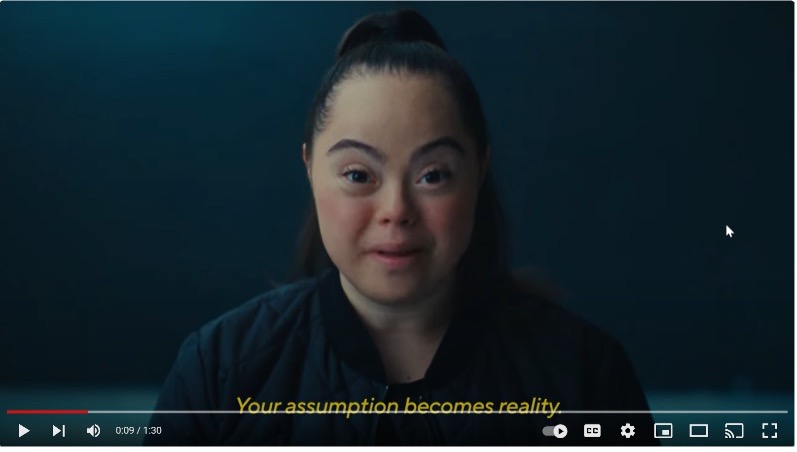
World Down Syndrome Day | 2024 | Length: 1:30 minsThis short video produced in honor of World Down Syndrome Day brilliantly illustrates myths and stereotypes that can limit the potential of people with Down Syndrome and people with disabilities in general!
To learn more about this topic see the article by CBS News that describes the background behind the video: Viral Ad Challenges Perceptions of Down Syndrome (Video)
Added: May 2024
Blended Practices for Teaching Young Children in Inclusive Settings, Second EditionBrookes PublishingThe second edition of this bestselling text shows early childhood teachers how to blend the best of special and general education, develop effective curricula, and improve outcomes for children with and without disabilities.
Added: Mar 2015 | Updated: Oct 2021
Books for Kids about Inclusion and AcceptanceBooks for kids about inclusion and acceptance in your home library.
Added: Feb 2017 | Updated: Feb 2019
Bookshare100 of the Best Picture Books with Image Descriptions of All Time selected by Readers of the School Library Journal Bookshare's library of over 370,000 digital accessible ebooks can helpt o facilitate lifelong learning and better inclusion for children with disabilities.
Added: Sep 2016 | Updated: Feb 2019
Bridges Newsletter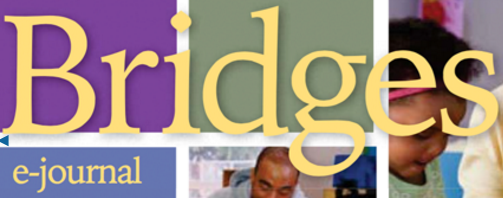
Published: California Department of Education
Each newsletter release offers the reader articles on a variety of topics of interest to teachers and administrators of early care and education programs.
Added: Mar 2015 | Updated: Apr 2019
Brookes Publishing: The Inclusion Lab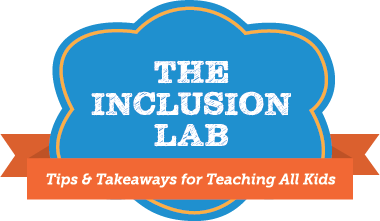
-
Additional Resources from Brookes Publishing: The Inclusion Lab
- Beyond Yes and No Tips on Helping Students with Severe Disabilities Expand Their Communication Skills, July 30, 2019
- Is Your Early Childhood Program Ready for Inclusion (Part 1-Physical Characteristics) June 16, 2019 This post which includes a handy printable form–will give you a starting point for gauging inclusion readiness by assessing your classroom’s physical characteristics.
- Is Your Early Childhood Program Ready for Inclusion (Part 2-Social Characteristics) June 18, 2019 This follow-up post to the June 16th post also includes a printable form and helps you to assess the social characteristics of your classroom
- 7 Clarifying Questions for IEP Meetings (PDF) May 2019
- Inclusion Beyond the Classroom May 2019
- 10 Tip Sheets on Inclusive Education May 2019
- 10 Steps to Starting Inclusion November 2018, Cheryl Jorgensen May 2019
- 10 IEP Tip Sheets Dec 2018
- 6 Ways to Create an Inclusive Culture Inside and Outside Your Classroom Dec 2018
- Reading Readiness Calendar Dec 2018
- 15 Tips on Supporting Emotional Regulation for Young Children with (and Without) Autism Sept 2018
- Technology Tools for Students with Autism (PDF) Sept 2018
- Is Your School Inclusive? Checklist (PDF) Sept 2018
- Inclusive Education 2018-2019 Calendar (PDF) Sept 2018
- Your Inclusion Transition Checklist: How to Support Students New to Inclusive Classrooms July 2018
- Happy Teacher Appreciation Week! 4 Great Resources for Free Teacher Tips July 2018
- edWeb Webinars: July 2018
- Infographic: Preschool Inclusion: How it Help Where to Start Added: July 2018
- 12 Key Practices for High-Quality Early Childhood Inclusion
Taken from the Inclusive Practice Profile (ICP Manual)
- Babbles to Books (PDF)
(Free book with section supporting children with disabilities)
- 2018 Social and Emotional Calendar
- Laying the Groundwork for Inclusion (PDF)
- Inclusive Classroom Profile (ICP) Webinar
Dr. Elena Soukakou, author of the ICP, explains how the ICP measures the quality of inclusive practices in early childhood settings. It is a structured observation rating scale designed to assess the quality of daily classroom practice that supports developmental needs of children 2 to 5 years of age with disabilities in early childhood settings.
- 2017-2018 Inclusion Heros Calendar
- Taking Care of Them, Taking Care of You Guide
Gain tips, ideas and advice to help stressed-out teachers and students with the free “Taking Care of Them, Taking Care of You” strategies for student support and teacher self-care. For teachers, the guide includes ideas for practicing mindfulness, tips for conflict resolution, and ways to build a support network. For students, there are activities for reducing stress in the classroom and techniques for countering bullying.
- 2017 Free Booklet: 10 Authors Share Strategies for Student Support and Teacher Self-Care
- Top 10 Free Resources for Inclusive Schools Week
- High Quality Preschool Inclusion: A few basics to help you get started
- Differentiated Instruction Tips
- Growing Strong 2017 Calendar Supporting Social and Emotional Development
- Fair Is Not Always Equal Poster
- Inclusion Success Story
- Ten Tips On Creating an Effective Inclusion Team
- Inclusion Resolutions: 10 Things to Do to Include All Students in the New Year
- Best Inclusion Resources
- 7 Key Features of Quality Inclusion (PDF) Infographic developed from the Preschool Inclusion Toolbox
- Eight Ways to Make Your Small Group Activities More Inclusive
- UDL Resources
- 6 Things Your Students with Disabilities Want You to Do –Poster
- 5 Types of Adaptations for your Inclusive Classroom
Added: Sep 2016 | Updated: Jun 2021
Building Blocks for Teaching Preschoolers with Special Needs (Third Edition)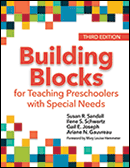
Published: May 2019 | Susan R. Sandall Ph.D. (Author), Dr. Ilene S. Schwartz Ph.D. BCBA-D (Author), Gail Joseph Ph.D. (Author), Dr. Ariane N. Gauvreau Ph.D. BCBA-D (Author), Dr. Mary Louise Hemmeter M.Ed. Ph.D. (Foreword)
Expanded with timely new content and consistent with DEC Recommended Practices, the third edition of this bestselling book will fully prepare a new generation of early childhood educators to teach and include every child. Like the groundbreaking previous editions, this updated Building Blocks guide gives pre‐ and inservice teachers three types of practical, evidence‐based inclusion strategies: curriculum modifications, embedded learning opportunities, and child‐focused instructional strategies.
Added: Mar 2015 | Updated: Jul 2019
Building Blocks Infographic: 6 Modifications for Your Early Ed Classroom
Brookes PublishingIncorporating a child’s favorite toy into a classroom area or activity is a simple but effective way to boost engagement in early learning environments. Adapted from Building Blocks for Teaching Preschoolers with Special Needs, this free download features six quick modification tips that can help make your early ed classroom more inclusive for all young learners.
Added: Jun 2023
Building Inclusive Child Care (BICC) Universal Design for LearningLink for video download found under "Related Links"Inclusive child care seeks the full integration of children with disabilities into the child care and pre-school setting. Accomplishing this goal requires the use of Universal Design for Learning (UDL) principles as well as working closely with families. The BICC Universal Design for Learning video and accompanying checklist is funded by the Pennsylvania Developmental Disabilities Council and administered by Northampton Community College in Bethlehem, Pennsylvania.
Added: Sep 2016 | Updated: Oct 2021
California Parent OrganizationsThis California Department of Education, Special Education Division website contains a list of California agencies providing resources for families of children with disabilities.
Added: Mar 2015 | Updated: Feb 2019
CARA‘S KIT Creating Adaptations for Routines and ActivitiesPromote the participation of all children in the full early childhood curriculum. This kit provides guidance for how to make adaptations for daily activities and routines so that children ages 3-6 with disabilities and other special needs can successfully participate in all classroom activities. Contains a CD with resources and a booklet about adaptations. From the Division for Early Childhood of the Council for Exceptional Children.
Milbourne, S. A., & Campbell, P.H., Philadelphia, PA: Child and Family Research Programs, Thomas Jefferson University. (2007).
- Cara’s Kit Mini Posters (PDF)
There are literally thousands of possible adaptations. Think of the adaptations in CARA’s Kit as a starting point. This tool provides you with two resources you may use when finding adaptations. These are:
- General adaptations: These adaptations may be implemented throughout the classroom on a regular basis.
- Adaptations specific to classroom learning areas: Adaptations are provided for the following learning areas: language and literacy; arts and creative expression; science and nature; water and sand; math and manipulatives; dramatic play; block play; music; and active learning and movement. In each case, the adaptations are presented as a mini-poster you can hang in the particular classroom area. In both resources, adaptations are organized according to CARA’s Adaptation Continuum, from least intrusive to most intrusive.
Added: Mar 2015 | Updated: Feb 2019
Cara’s Kit for ToddlersBrookes PublishingTo make sure all toddlers in your early childhood program are participating, learning, and thriving, you need to master the art of choosing and using effective adaptations. Practical solutions are in CARA's Kit: a guidebook and CD-ROM brimming with step-by-step ideas for adapting environments, activities, and materials for children 18 to 36 months.
A follow-up to the bestselling CARA's Kit for Preschoolers, this real-world guide to successful adaptations is aligned with recommended practices in early childhood special education and early intervention.
Added: Oct 2021
Cara’s Kit Self-Guided Module: Creating Adaptations for Routines and Activities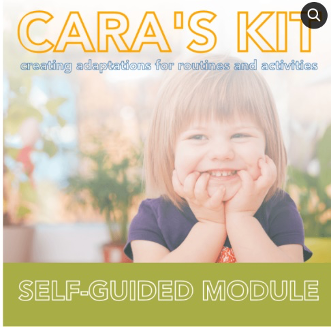
Connect Modules & DECAccess this learning module to explore each topic of CARA’s Kit, from the introduction to the process to example adaptations.
NOTE: The module at this link is FREE. If you would like a PD certificate of completion for the module ($10 per certificate), please start here instead.
About CARA’s Kit: CARA’s Kit, created by Philippa H. Campbell & Suzanne A. Milbourne and published in 2007, is designed for teachers and consultants who are involved in providing early care and education for children under age 6. CARA’s kit contains information on how to make adaptations for individuals or groups of children who are experiencing challenges during everyday routines and activities.
CARA’s Kit Materials to accompany the online module are available here: Order the CARA’s Kit publication here.
CARA’s Kit online was developed by Pennsylvania Early Intervention Technical Assistance with funding from the Pennsylvania Office of Child Development and Early Learning. CARA’s Kit online is hosted by the Division for Early Childhood of the Council for Exceptional Children.
Added: Feb 2021
Celebrating Disability Pride Month (July) With Books for All Ages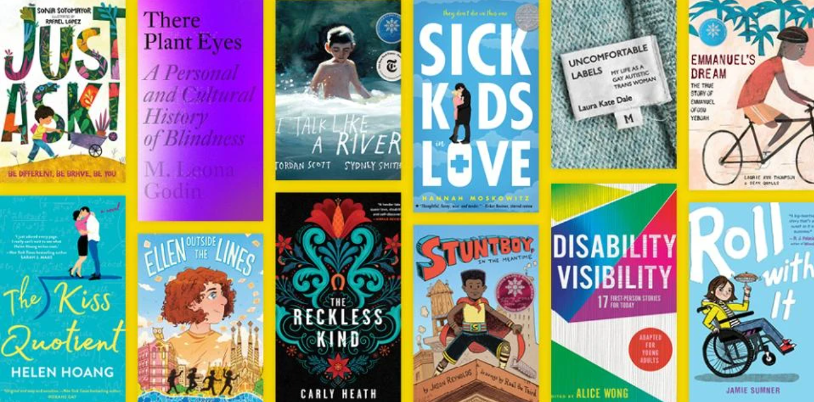
New York Public Library | July 1, 2022 ”Welcome to Disability Pride Month! Celebrated in July to commemorate the passage of the Americans with Disabilities Act (ADA) into law in July, 1990, it's a time to celebrate people with disabilities which is roughly 15% of the world’s population and 1 in 4 Americans. Not every disability is visible or obvious and anyone of any age can be disabled.”
“Maybe you yourself are disabled and want to finally see yourself in the books you read; maybe someone you love is disabled and you want to learn more to meet them where they are; maybe you’ve realized that you’ve never read a book by a disabled author and want to change that; or maybe you just want a book that reflects the diversity of the world around you. This booklist spans all age groups, genres, and formats, from children’s picture books and teen novels to adult poetry, nonfiction, memoirs, and more.”
Added: Jul 2022
Center for Early Literacy Learning (CELL)The goal of the Center for Early Literacy Learning (CELL) is to promote the adoption and sustained use of evidence-based early literacy learning practices. This site has resources for early childhood intervention practitioners, parents, and other caregivers of children, birth to five years of age, with identified disabilities, developmental delays, and those at-risk for poor outcomes.
- Spanish Practice Guides for Use with Parents
Parents who speak Spanish may use these products to provide their infants, toddlers, or preschoolers with fun and exciting literacy learning experiences. Practitioners working with parents who speak Spanish may also find these helpful.
- CELL Videos
CELL videos are designed for the teacher, parent, trainer, coach and home visitor. Each video introduces and illustrates a key component of the CELL Early Literacy Learning Model.
Added: Mar 2015 | Updated: Feb 2019
Center for Inclusive Child Care (CICC)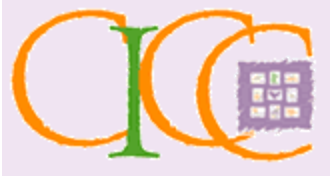
The mission of the Center for Inclusive Child Care is to create, promote and support pathways to successful inclusive care for all children. The project is a comprehensive resource network for promoting and supporting inclusive early childhood and school-age programs and providers. We provide leadership, administrative support, training, and consultation to early care and education providers, school-age care providers, parents, and the professionals who support providers and parents of children with special needs. The Center for Inclusive Child care envisions weaving the common threads of knowledge, respect and sensitivity to create and sustain opportunities for high quality, culturally responsive inclusive care in which children and their families are supported and nurtured.
Added: Aug 2014 | Updated: Dec 2019
Center for Parent Information and Resources (CPIR)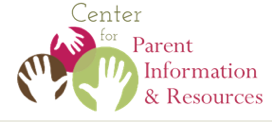
The Center for Parent Information and Resources (CPIR), produced under the US Department of Education Office of Special Education, serves as a central resource of information and products to the community of Parent Training Information (PTI) Centers and the Community Parent Resource Centers (CPRCs), so that they can focus their efforts on serving families of children with disabilities. The site provides resources by topic area, some in English and Spanish and when available, by state.
-
Additional Resources from CPIR
- Trauma Informed Resource Collection Dec 2018
- Tools That Empower Spanish Speaking Families
- Index to Resources in Spanish for English speakers and link to the index that is entirely in Spanish
- A Resource Collection on Positive Behavior Supports, Functional Behavioral Assessment, and School Discipline Nov 2017
Welcome to this collection of resources on positive behavior supports and discipline of children with disabilities. The collection has been developed by a team of Parent Centers, specifically for the Parent Center network to use in their work supporting and empowering parents and families of children with disabilities.
- Rare Disorders: Disability Fact Sheet Published: June 2017
Roughly 7,000 rare diseases/disorders have been identified as affecting the human race. Because they are rare, it can be a real challenge for a person to be accurately diagnosed. Finding effective treatments, especially medicine, can also be a challenge—and for the same reason. Rareness.
If you have a rare disease, know someone who does, or work with people who might, here’s a core of resources we hope are helpful.
- Parent Technical Assistance Centers
Parent centers work to improve educational outcomes for children and youth with all disabilities (emotional, learning, mental, and physical). There are ten parent centers in California.
- Fact Sheet on the Rights of Immigrant Children
- NICHCY's New Home Sept 2014
September 30, 2014 was NICHCY's last day after more than 20 years of service. Happily, most of NICHCY's resources will stay in their new home at the Center for Parent Information and Resources.
- Developing culturally Responsive Approaches to Serving Diverse Populations: A Resource Guide for Community-Based Organizations Mar 2017
This 30-page resource guide, produced by the National Research Center on Hispanic Children and Families, identifies easily accessible resources on cultural competency that CBOs can use to become more responsive to the needs of their targeted populations, and to help attract funds to support their important work.
Added: Oct 2014 | Updated: Jul 2019
Child Care Plus+The Center on Inclusion in Early Childhood is dedicated to sharing knowledge, fostering skills, and encouraging attitudes that promote inclusion as a core component of excellence in early childhood. The website offers a variety of products, informational newsletters and links to help teach individuals more about inclusion. The organization conducts a variety of trainings and studies, all of which are described on the website.
Added: Mar 2015 | Updated: Feb 2019
Children’s Books That Feature Characters with Disabilities
Huffington Post | February 8, 2021It’s important for children to feel represented in the books they read. It’s also important for books to expose children to the beautiful diversity of our world.
This includes the varying abilities and disabilities around the globe. To promote inclusivity and representation, we’ve rounded up 53 books featuring characters with disabilities.
In these books, either the main character or a secondary character has a disability. Many of the books feature disability as the main storyline, but it’s not central to the plot in others.
Added: Jun 2021
Coaching for Diversity, Equity, Inclusion, Accessibility, and Belonging in Early Childhood-A Step-by-Step Guide for Programs and Schools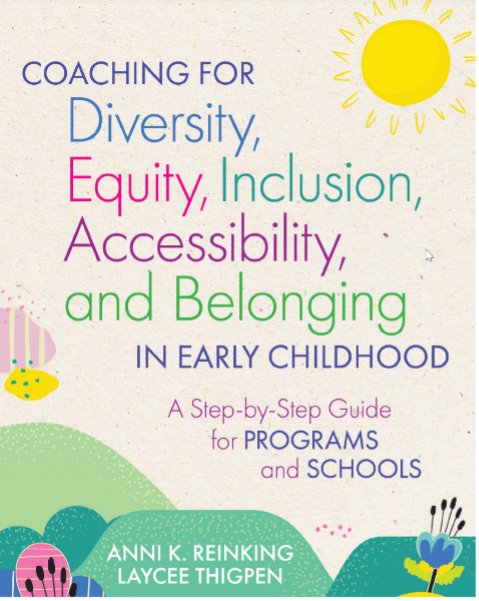
Brookes Publishing | 2023We were asked to write this book as a way to share our knowledge regarding the work we do that focuses on educating programs to build equitable environments for all students, families, and educators. As the preschool population becomes more diverse, educational organizations must address the embedded, historically inequitable practices and policies to meet the needs of the inevitable diversity in every community in the United States. There is diversity of thought, diversity of race/ethnicity, diversity of socioeconomics, diversity of sexuality and gender, diversity of religion, diversity of ability, diversity of age, and diversity of experiences. Each of these diverse identities has been, and continues to be, part of early learning environments. Therefore, it is imperative to do this work and to start or continue the conversations regarding transforming early childhood environments to be inclusive for all. Overall, the information in this book will provide a how-to model filled with reflection questions, activities, and resources, with the overarching theme of DEIAB.
Read an Excerpt (PDF)
Read this blog: Can’t We Just Keep Things Like They Are? 4 Equity Myths in Early Childhood
Published: April 2023
In their new book Coaching for Diversity, Equity, Inclusion, Accessibility, and Belonging in Early Childhood, Anni K. Reinking and Laycee Thigpen address some of these myths that persist when discussing equity-focused work. Excerpted and lightly adapted from the book, today’s post is a good starting point for vital conversations around inequitable practices and policies.
Added: Jun 2023 | Updated: Sep 2023
CONNECT ModulesFrom Frank Porter Graham at the University of North Carolina the Connect Modules provide training on practices to solve dilemmas in early childhood settings with videos, activities and narratives to guide you through a process to learn about serving children with disabilities effectively. Modules include PowerPoints, videos, activities and reflective questions for use in providing in-service or pre-service training. Also available are online training modules. See the link below.
Added: Mar 2015 | Updated: Feb 2019
ConnectAbilityConnectAbility is a Canadian website and virtual community dedicated to lifelong learning and support for people who have an intellectual disability, their families and support networks. The core of our community is accessible, self-directed access to valuable information and tools, ready on demand. Unique features include “Tip Sheets,” “Workshops” and “Radio Shows.”
Added: Mar 2015 | Updated: Feb 2019
Curriculum Modifications for Infants and Toddlers, Training Module and Resources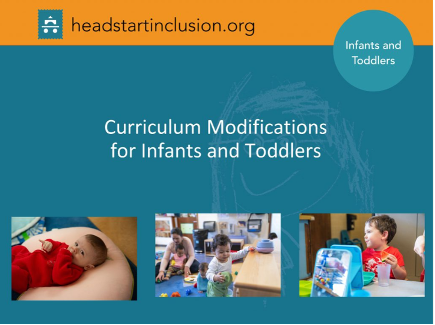
Head Start InclusionThese resources were developed to provide information about curriculum modifications and adaptations for infants and toddlers. Examples include modifications that can be used in a variety of home and program settings. The resources include a set of presentation slides, presenter notes, and additional resources on choosing modifications, types of modifications, and child vignettes for use in professional development.
Added: Feb 2021
DEC Recommended Practices: A Comprehensive Guide for Practical Application in Early Intervention/Early Childhood Special EducationUpdated: Oct 2014
A DEC initiative that bridges the gap between research and practice, offering guidance to parents and professionals who work with young children who have or are at risk for developmental delays or disabilities.
Added: Mar 2015 | Updated: Feb 2019
Differentiation in Preschool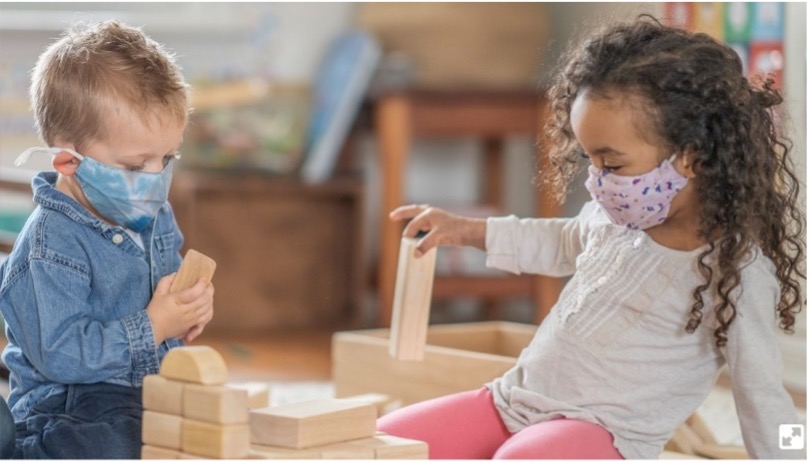
Edutopia | September 16, 2021Differentiated instruction allows us to tailor our teaching to the needs of individual students. Is it possible to offer very young children differentiated learning contexts and challenges? Does it involve too much extra planning, materials, or space?
From my experience, it’s not only possible but absolutely necessary to give these young students the chance to enjoy the learning experience fully. We need to offer learning contexts, tasks, and activities that carry the appropriate challenge and involve the child’s interests. We must also set reachable skills development goals, so that every child can participate in the learning experience feeling self-assured.
This article tells you how to get started and provides two examples of differentiated instruction in action.
Added: Oct 2021
Disability Is NaturalThis Web site created by Kathie Snow includes her widely used article on “people-first language” and other resources to support inclusion. She challenges outdated ways of thinking and helps parents, people with disabilities, and professionals acquire new perceptions and attitudes—the first rung on the ladder of change.
Added: Aug 2014 | Updated: Mar 2019
Disability Resources Monthly (DRM) Regional Resource Directory: CaliforniaThis site has an extensive list of links to nonprofit organizations and government agencies serving people with disabilities in California.
Added: Mar 2015 | Updated: Feb 2019
Disability Social History ProjectPeople with disabilities have an exciting and rich history that should be shared with the world. This website is dedicated to sharing this history. Features include a timeline of disability history, a list of famous people with disabilities, bibliographies of specific disability areas, and a section of website links.
Added: Mar 2015 | Updated: Feb 2019
Division for Early Childhood (DEC)The Division for Early Childhood (DEC) is an organization designed for individuals who work with—or on behalf of—children with special needs, birth through age eight, and their families. DEC, a subdivision of the Council for Exceptional Children (CEC), is dedicated to promoting policies and practices that support families and enhance the optimal development of children. Children with special needs include those who have disabilities or developmental delays, are gifted/talented, or are at risk of future developmental problems.
- Resources within Reason
Resources Within Reason is a bi-monthly, one-way listserv. Each issue focuses on a topic of interest to individuals who support young children and their families, with emphasis on children with or at risk for disabilities. All featured resources are free. The content of Resources within Reason is coordinated by Camille Catlett. The listserv is supported by DEC. All or part of Resources within Reason may be freely shared or copied.
- Recommended Practices: A Comprehensive Guide for Practical Application in Early Intervention/Early Childhood Special Education
A DEC initiative that bridges the gap between research and practice, offering guidance to parents and professionals who work with young children who have or are at risk for developmental delays or disabilities.
Added: Aug 2014 | Updated: Mar 2019
Early Childhood Inclusion Joint Position Statement by DEC and NAEYC (PDF)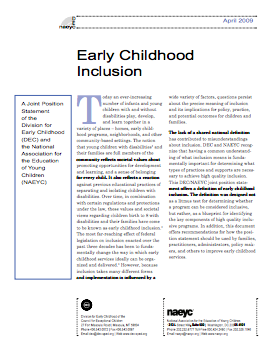
A Joint Position Statement of the Division for Early Childhood (DEC) and the National Association for the Education of Young Children (NAEYC)
Added: Jul 2016 | Updated: Apr 2019
Early Childhood Technical Assistance (ECTA)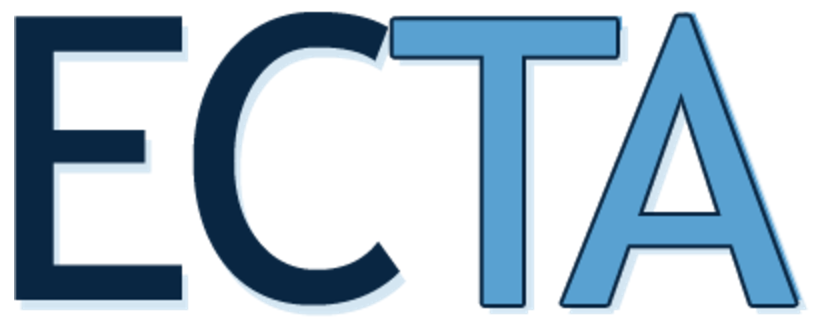
ECTA is comprised of several recent OSEP-funded TA centers (NECTAC, CELL and TACSEI and ECO within the next two years). The purpose of ECTA is to improve state early intervention and early childhood special education service systems, increase the implementation of effective practices, and enhance the outcomes of these programs for young children and their families.
-
Additional Resources from Early Childhood Technical Assistance Center
- State Early Childhood Inclusion Self-Assessment (PDF) July 2017
- Pennsylvania Preschool Inclusion Self-Evaluation Tool
- ECTA Center for Families to help families understand their right under the Individuals with Disabilities Education Act (IDEA), connect with other families and find high quality resources related to caring for infants, toddlers and young children with disabilities.
- Recursos en Español (Resources in Spanish)
- Inclusion in Least Restrictive Environments
Designed for the administrators of state agencies responsible for services to young children and their families, including child care, Head Start, education, and early intervention. It has compiled information for administrators who are challenged with developing policies and programs that lead to inclusive comprehensive and coordinated services for all young children, ages birth to 8 years, and their families.
- Preschool Inclusion Finance Toolkit 2017 (PDF)
An update of ECTA Center's resource that addresses updated guidance in the Dear Colleague Letter on Preschool Least Restrictive Environments published earlier this year. Worksheets included in this toolkit:
- Early Intervention Program for Infants and Toddlers with Disabilities (Part C of IDEA)
Provides a listing by state of the websites of the organizations responsible for early intervention for babies with developmental disabilities
- Developing High Quality Functional IFSP and IEP Goals –Training Package
This training package has been developed collaboratively with staff from the ECTA Center and WRRC in response to the need expressed from state and local providers to have specific information and resources about developing Individualized Family Service Plan (IFSP) outcomes and Individualized Education Plan (IEP) goals. First introduced in September 2012, this revised training package includes: an introductory video; a set of six fully scripted PowerPoint presentations; handouts, activities and supplemental materials; and how states have used and adapted the materials.
- Inclusion in Least Restrictive Environments
- Position Statements on Inclusion from National Organizations
- Research and Studies on Inclusion
- Personnel Development for Inclusion
- Recommended Practices
The OSEP funded Early Childhood Technical Assistance Center (ECTA) has launched a campaign to bring widespread awareness about the DEC Recommended Practices (RPs). The latest ECTA resources to support implementation of the RPs include Performance Checklists for practitioners as well as Practice Guides for Practitioners and Practice Guides for Families. These resources were highlighted on a recent national webinar which was recorded and can be accessed in aRPy's Corner of the ECTA web site.
- ECTA Webinar Series: Upcoming and Archived:
Added: Oct 2014 | Updated: Jan 2021
Early Childhood Technical Assistance (ECTA) DASY COVID-19 Family Resources Interactive Infographic (PDF)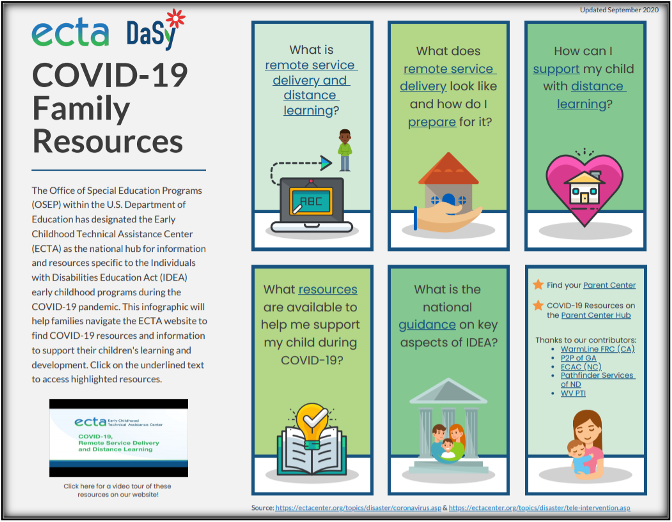
The Office of Special Education Programs (OSEP) within the U.S. Department of Education has designated the Early Childhood Technical Assistance Center (ECTA) as the national hub for information and resources specific to the Individuals with Disabilities Education Act (IDEA) early childhood programs during the COVID-19 pandemic. This infographic will help families navigate the ECTA website to find COVID-19 resources and information to support their children's learning and development. Click on the underlined text to access highlighted resources.
Added: Jan 2021 | Updated: Mar 2022
Early Childhood Technical Assistance (ECTA): Bringing Inclusion to Life in a Virtual World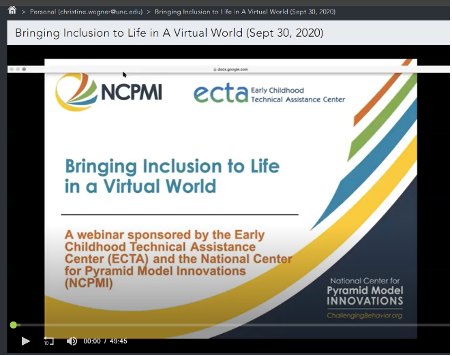
September 2020This webinar presented jointly by the Early Childhood Technical Assistance Center (ECTA) and the National Center for Pyramid Model Innovations (NCPMI) explores how inclusive practices can be implemented by providers delivering services being delivered remotely, in a hybrid manner (with some in-person learning and some remote), or in-person but with health and social distancing restrictions. Examples from sites as well as guiding questions to support innovation are shared. The webinar is hosted by Dr. Phil Strain and refers to specific
Early Childhood Education Environment (ECEE) Inclusion Indicators that were introduced in a webinar presented by ECTA and NCPMI in the fall of 2019, Early Childhood Indicators of High-Quality Inclusion.
Added: Jan 2021
Early Childhood Transition Guide Book: What You Need to Know Before Your Child’s Third Birthday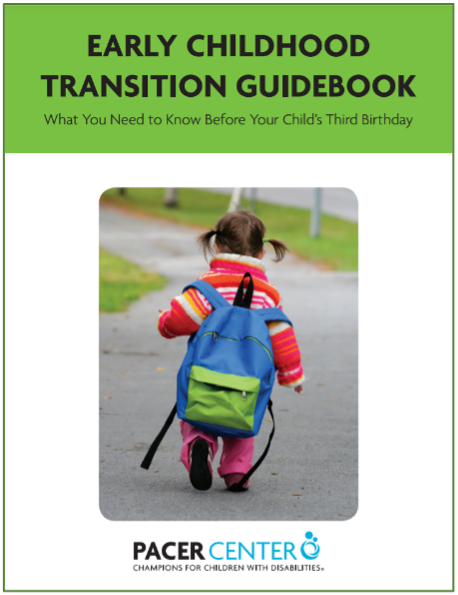
PACER CenterA child’s third birthday is an important day. Aside from being a time to celebrate, it also marks the transition from California Early Start Early Intervention Services to a preschool option. This transition changes the services available to families and how they are provided, as the focus moves from the child with a disability or developmental delay and the family to just the child. This free, downloadable, 11 page guidebook includes information on what transition is, how and when to plan for it, how to determine if a child is eligible for special education services, how to implement the transition plan, and what to do if the child is not eligible for special education services. Find tips and facts that can help families plan for this important change in services before age three.
Added: Jul 2022
Early Choices Illinois Inclusion Initiative YouTube ChannelEarly CHOICESThe Early CHOICES inclusion initiative promotes increasing high quality inclusive early care and education for each and every child birth to age 5. Our goal is to increase the number of children with disabilities receiving specialized services in regular early care and education settings.
Added: May 2024
Early CHOICES Inclusion Initiative Resources
Early CHOICESThe Early CHOICES, Illinois Inclusion Initiative promotes increasing high quality inclusive early care and education for each and every child birth to age 5. Our goal is to increase the number of children with disabilities receiving specialized services in regular early care and education settings. The website holds free on demand training modules, Understanding Inclusion, for care providers and families. Find this and other resources in the links below.
Illinois Inclusion Brochure (PDF) provides an example of a framework of information on inclusion that would be helpful for famililies.
Added: May 2024
Early Choices YouTube ChannelPlaylist for early childhood programs with interviews with teachers, therapists, and parents and clips of inclusion in action. Below is a sample video of an interview with parents of children who had been included.
Added: Feb 2021
Early Inclusion Toolkit Video Playlist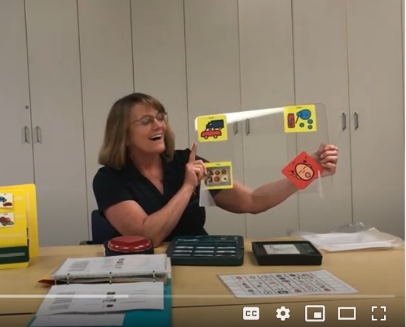
February 2020Created by Parents Helping Parents and the Inclusion Collaborative of Santa Clara County, CA through a grant.
The sample video, Early Learning Tool Kit: Visual Tools and Binder Materials, Parents Helping Parents (Video), provides information about the tools that may help the children in your preschool class who are visual learners, as well as the materials that are in the binder. These tools are all included in the Early Learning Tool Kit. If you have any questions about these tools, or if you are interested in finding out about additional tools and strategies that can help you create an inclusive preschool classroom, contact us at Parents Helping Parents- info@php.com, or (408)727-5775.
Added: Jan 2021
Early Intervention Strategies for SuccessEarly Intervention Strategies for Success is a blog produced by the Virginia Early Intervention Professional Development Center. It offers practical articles and discussions about implementing early intervention supports and strategies. Tips and strategies useful when working with families of infants and toddlers with special needs within the context of their everyday routines are provided along with best practices, follow-up from professional development activities, and other topics relevant to early interventionists in Virginia. The strategies are relevant to home visitors and early interventionists from any state.
Added: Oct 2014 | Updated: Feb 2019
Early Intervention Video Library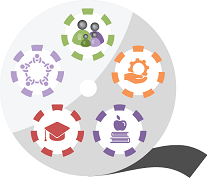
Looking for videos about Early Intervention? You've come to the right place!There is nothing as powerful as seeing early intervention (EI) in action or hearing about the impact of intervention from families and service providers! This video library is designed to be a central resource for EI videos which can be used for professional development, preservice preparation, public awareness, and individual study. These videos address a variety of topics and represent EI as provided in a variety of states. All videos embedded in this site are available as free resources. This video library is a collaborative project of the
Early intervention-Early Childhood Professional Development Community of Practice (EI-EC PD CoP) and the
Virginia Early Intervention Professional Development Center.
Added: Sep 2016 | Updated: Feb 2019
ECTA: Preschool During the Pandemic: Early Childhood Education in Extraordinary Times – 12 Episode Video Series by Larry Edleman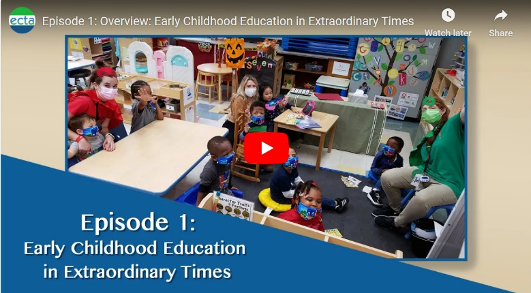
Early Childhood Technical Assistance (ECTA) | January 20, 2021This 12 episode series shares the experiences of practitioners and families from across the country, illustrating how the fields of early education and early childhood special education are successfully supporting preschoolers and their families during the COVID-19 pandemic.
Also see MAP Newsletter for 2020 related to supporting early care and learning during COVID-19.
Added: Feb 2021
Edutopia
Edutopia is dedicated to transforming kindergarten through 12th-grade (K-12) education so all students can thrive in their studies, careers, and adult lives. We are focused on practices and programs that help students acquire and effectively apply the knowledge, attitudes, skills and beliefs to achieve their full potential.
-
Additional Resources from Edutopia
Family Engagement
Healthy Mind, Healthy Body
- The New PE: Special Report: Students Learn That Active Bodies Lead to Active Minds
As research linking physical fitness to academic success continues to emerge teachers are coming up with creative ways to keep kids active during teaching time, instead of relying on recess and those ever-dwindling PE hours. Teachers say they find that using movement in the classroom doesn't just get the jitters out, but actually makes for better learning as well, because engaging students' bodies in turn activates their minds.
- Move Your Body, Grow Your Brain
Incorporating exercise and movement throughout the school day makes students less fidgety and more focused on learning. Improving on-task behavior and reducing classroom management challenges are among the most obvious benefits of adding physical activities to your teaching toolkit. As research continues to explore how exercise facilitates the brain's readiness and ability to learn and retain information, we recommend several strategies to use with students and to boost teachers' body and brain health. The article includes the following resources:
- Brain Breaks
Physical activity ideas in the classroom from the Michigan Department of Education
- Just Breathe: When Teachers Practice Mindfulness
In this Edutopia blog by Elena Auguilar she introduces Meena Srinivasan's new book,Teach, Breathe, Learn: Mindfulness In and Out of the Classroom. She describes it as a resource that "speaks to a yearning I hear across our country: a desire to teach and work in a way that is anchored in joy, emerging from compassion, and that is more humane and slower than the way we work now." This easy-to-read book is a roadmap for this desire. She introduces a variety of mindfulness practices and then offers a wealth of resources for how to integrate these into our lives and classrooms.
- Energy and Calm: Brain Breaks and Focused Attention Practices
- Simple Music Integration for Primary Classrooms
The blog describes five easy ways for primary teachers to integrate music into their classrooms. Each activity is specifically designed for individuals of all backgrounds and abilities, and none require musical training or experience. So why use music in your primary classroom? Well-designed music activities can deepen and reinforce knowledge and skill development across a wide range of subjects. Music is engaging, fun, and can motivate even the most detached students.
- Empathy In the Classroom: Why Should I Care?
- The Long Game: 4 Essentials for a Successful Mindfulness Program
- Social Emotional Learning: A Schoolwide Approach
Strategies like mindfulness, emotional regulation, and supportive small groups help Symonds meet the academic and social needs of their students.
- Empathy In the Classroom: Why Should I Care?
- The Long Game: 4 Essentials for a Successful Mindfulness Program
- Social Emotional Learning: A Schoolwide Approach
Strategies like mindfulness, emotional regulation, and supportive small groups help Symonds meet the academic and social needs of their students.
- Resources on Mindfulness in Education
- Positive Strategies to Avoid Stress, Anxiety and Burnout
- 5 Simple Lessons for Social and Emotional Learning for Adults
- How Emotions Affect Learning, Behaviors and Relationships
Bring lessons from the movie "Inside Out" into your classroom
- Islands of Personality and Trains of Thought (Inside Out)
Added: Mar 2015 | Updated: Feb 2019
Embedded Instruction: An Interview with Patricia Snyder, Ph.D. (Video)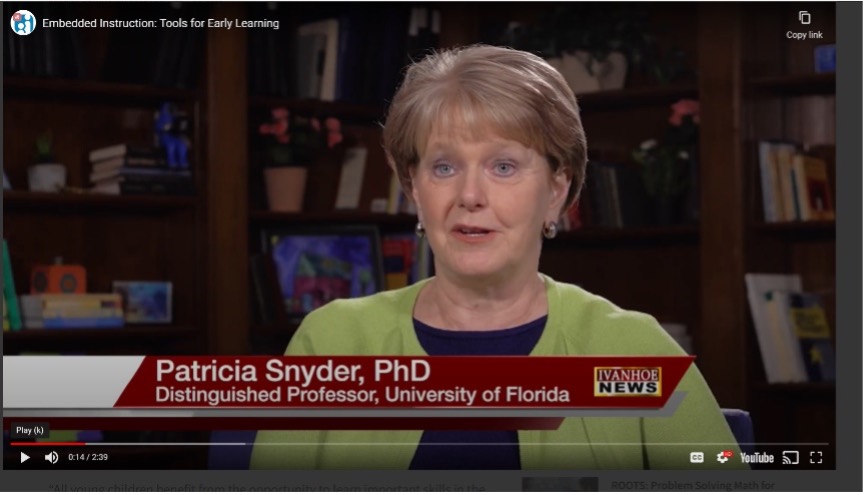
May 16, 2021 | Length: 8 minsIn this Q and A with Patricia Snyder, she describes embedded instruction and the education of children with disabilities along side their typically developing skills.
Added: Jul 2022
Embedded Instruction: Tools for Early LearningMay 20, 2021GAINESVILLE, Fla. (Ivanhoe Newswire)—In 2019, more than 716,000 preschool-age children received special education services. Yet only 38 percent received these services through the early childhood program they attended. Ivanhoe has details on an intervention that supports all children’s learning in their everyday activities and routines at school, at home, and in the community.
Added: Jul 2022
Experiencing Inclusion Through the Pyramid Model
- Date: March 19, 2021
- Length: 54 minutes
The Pyramid Model for Supporting Social Emotional Competence in Infants and Young Children is designed to promote the inclusion of children with disabilities within community programs. In states where there is a focus on increasing the use of high-quality inclusion practices, the implementation and scale-up of the Pyramid Model offers an effective approach. Join us for a webinar featuring new products and resources focused on increasing the use of inclusive practices in Pyramid Model programs to better support children diagnosed with disabilities or needing individualized supports. Learn about important research, statewide implementation potential and an assessment used to support inclusive practices in the classroom.
Added: Jun 2021 | Updated: Sep 2023
Family Engagement: Collaborating with families of students with disabilities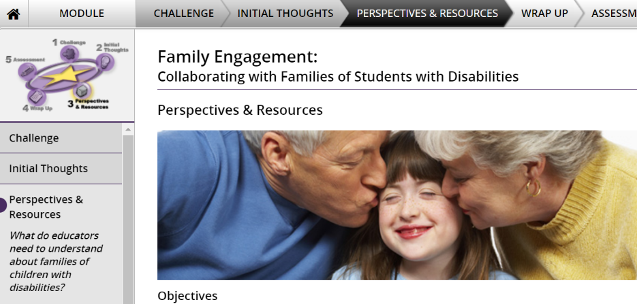
The IRIS Center Module | (2008, 2020)This one-hour training module—a revision of Collaborating with Families, which was originally developed in cooperation with the PACER Center—addresses the importance of engaging the families of students with disabilities in their child’s education. It highlights some of the key factors that affect these families and outlines some practical ways to build relationships and create opportunities for involvement. The recently updated module includes insightful questions for early childhood educators to reflect on as they learn first-hand from the voices of families about their experiences and the joys and challenges of raising a child with a disability. One section (Page 7 under Perspectives and Resources) is devoted to issues related to COVID-19 and its impact on families of children with disabilities.
Added: Jan 2021
First Barbie with Down Syndrome (Video)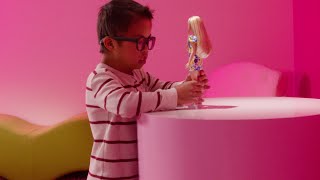
April 2023 | Length: 3:36 minutesIn partnership with the National Down Syndrome Society, the newest Barbie fashion doll was designed with purpose and inclusivity at the heart of every choice. With a shorter frame, rounder face, smaller features, and palms including a single line, this doll introduces a new sculpt and details illustrative of common characteristics of women with Down syndrome. Dressed in the colors and symbols of the community, she wears matching ankle foot orthotics, and a three-chevron necklace representing the three copies of the 21st chromosome. This results in the characteristics associated with Down syndrome – and represents “the lucky few” who have someone with Down syndrome in their life.
This video shares the positive responses of families and people with Down Syndrome to the new Barbie.
Added: Jun 2023 | Updated: Sep 2023
First SignsWith developmental, behavioral, and learning disabilities on the rise, there is much that remains poorly understood, from cause to cure. However, there is one widely-accepted fact: early and intensive intervention can have a profound impact on the quality of life for children at risk and their families.
The key is early detection. But
recognizing the early signs can be a challenge for parents and healthcare professionals alike. The First Signs website provides a wealth of vital resources, covering a range of issues: from
monitoring development, to
concerns about a child; from the
screening and referral process, to
sharing concerns. We invite you to explore our website in your search for answers.
Added: Mar 2015 | Updated: Feb 2019
Frank Porter Graham Child Development Institute
The
Professional Development Center at FPG (PDC@FPG) provides people and organizations with opportunities to expand capacity, knowledge, and skills in areas related to child development and learning. PDC offerings are based on evidence-based content and strategies for supporting adult learners. Professional development options include: Institutes and Intensive Workshops, Online Learning, Technical Assistance Services, and Study Visits.
-
Additional Resources from Frank Porter Graham
Healthy Mind, Healthy Body
- Resources Within Reason
Compiled by Camille Catlett and Erin E. Barton, this one page resource gives you easy access to the definition of inclusion, benefits of inclusion, research findings and access to essential examples of inclusion.
- Mindfulness Helps Adults Overcome Childhood Adversity
With significant implications for early childhood education, new research reveals that a mindful disposition is associated with alleviating lasting physical and emotional effects of childhood adversity. A team of scientists from Temple University, UNC's Frank Porter Graham Child Development Institute (FPG), Child Trends, and the Rockefeller University conducted the groundbreaking study—the first to examine relationships between childhood adversity, mindfulness, and adult health.
- Teachers Play a Key Role in Program to Fight Childhood Obesity
An innovative physical activities guide developed at the Frank Porter Graham Child Development Institute (FPG) is helping North Carolina fight childhood obesity. New research shows that when teachers direct these physical activities, young children become more active and less sedentary. A sample of activities from the Be Active Kids Guide to Early Childhood Physical Activity is available for download.
Inclusive Practice
- Baby Talk Added: February 2017
Resources to Support the People Who Work with Infants and Toddlers is a free newsletter by Camille Catlett, distributed monthly. Each issue features resources that are high quality and readily available at no cost.
- Resources Within Reason Added: February 2017
Compiled by Camille Catlett and Erin E. Barton, this one page resource gives you easy access to the definition of inclusion, benefits of inclusion, research findings and access to essential examples of inclusion.
- National Center on Early childhood Development, Teaching, and Learning (ECDTL) Webinar Series on High Quality Inclusion
- Webinar #1 Partnerships for Inclusion
- Webinar #2 Supporting Participation for All Children: Essential Features of High-quality Inclusion
- Webinar #3 Partnerships for Inclusion: Supports that Ensure High-Quality Inclusion
Training & Technical Assistance
- More Than Baby Talk 10 Ways to Promote The Language and Communication Skills of Infants and Toddlers This brief guide describes ten practices that early childhood teachers can use to foster language and communication skills among infants and toddlers. The guidelines are based upon the latest research findings on optimal adult-child interactions for promoting strong language and communication skills among young children.
- AFIRM Autism Focused Intervention Resources and Training Modules-How to use Visual Supports
AFIRM Modules are designed to help you learn the step-by-step process of planning for, using, and monitoring an evidence-based-practices with learners with autism spectrum disorder from birth to 22 years of age. Supplemental materials and handouts are available for download.
- Online Courses on Inclusion for CEUs
"Foundations of Inclusion" module is free all other course are priced at $30 per participant.
- Dual Language Learners: Strategies for Successful Opportunities in ECE- 2016 Free Training Module
This free module provides an overview of the cognitive, social-emotional, and language development of dual language learners (DLLs) as well as examples of how early childhood professionals can support children. Through the content, videos, and reflection assignments, professionals will begin to identify ways to support DLLs in their own care settings.
Added: Mar 2015 | Updated: Feb 2019
Friendship Circle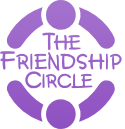
Friendship Circle of Michigan is a non-profit organization that provides programs and support to the families of individuals with special needs. With over 75,000 visitors a month, the Friendship Circle Special Needs Resource blog is one of the biggest special needs blogs in the world. Currently the blog has over 500 articles on special needs topics including: parenting, special education, products, therapy tips, videos and more.
Added: Mar 2015 | Updated: Feb 2019
Great Expectations Inclusive Preschool (Video)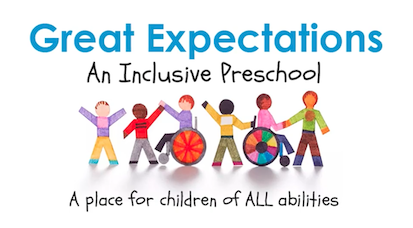
Marin County | January 17, 2019 | Length: 3:28 mins“A collaboration with Lifehouse Agency, the Marin County Office of Education and Dominican University to bring the first inclusive Preschool to Marin County. Let's learn and play together to foster compassion, diversity, and leadership in the young child!” Video describes the benefits of inclusion for all children and shows ‘push in’ occupational therapy.
Added: Mar 2022
Hayward Unified School District Early Learning Inclusive Practices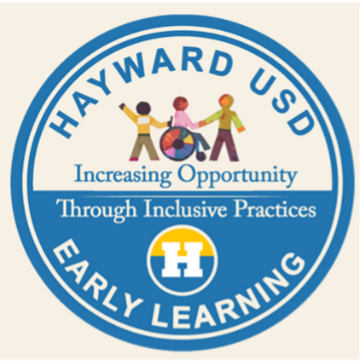
Hayward Unified School District has created a website focused on inclusive practices funded through their Inclusive Early Education Expansion Program (IEEEP) grant, and is designed to provide a "one-stop" resource for the Hayward birth to eight community, interested in supporting inclusive practice. It includes Professional Development resources listed by topic area. View the website at https://www.earlylearninginclusion.org/.
Added: Jul 2022
Head Start Center for Inclusion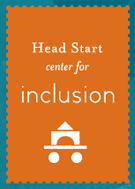
Our overarching goal is to increase the competence, confidence, and effectiveness of personnel in Head Start programs to include children with disabilities. Look here for training materials, tools for teachers and coordinators, as well as other resources.
Added: Jan 2017 | Updated: Feb 2019
Head Start Center for Inclusion Website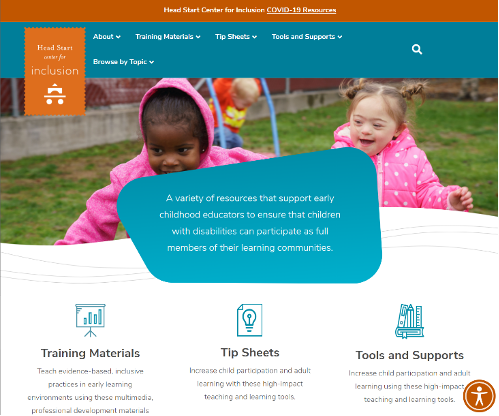
New Resources:
- Disability Information Guides
- Frequently Asked Questions: Infants and Toddlers
- Tip Sheets for Infants and Toddlers
- Mini-Suites: Infants and Toddlers
- Video: Infants and Toddlers
Added: Jan 2021
Head Start ECLKC: Children with Disabilities
Young children vary in their skills, knowledge, backgrounds, and abilities. Effective teaching requires individualized teaching and chances to learn for all children to access, participate, and thrive in early learning settings. Individualizing for children who need more support helps ensure effective teaching for children with disabilities and other special needs across all the Head Start Early Childhood Learning & Knowledge Center (ECLKC) Learning Outcomes Framework domains. Using children's Individualized Family Service Plan (IFSP) and Individualized Education Program (IEP) goals is part of effective teaching, individualizing, and creating inclusive environments to support children's positive outcomes.
Added: Jun 2017 | Updated: Aug 2019
Head Start ECLKC: Curriculum Modifications An Introduction: Video and resources
Length: 4:30 minsThis in-service suite gives an overview of eight types of curriculum modifications. Teachers can use these simple changes to classroom activities to increase a child’s engagement and learning. A training PowerPoint and materials are included.
Added: Jan 2021
Head Start ECLKC: Disabilities Services Newsletters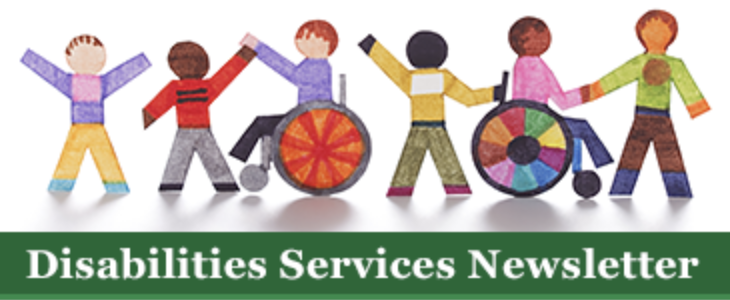
The Head Start Early Childhood Learning & Knowledge Center (ECLKC) Disabilities Services Newsletter is produced monthly by the National Center on Early Childhood Development, Teaching, and Learning (NCECDTL). It is dedicated to staff working with young children with disabilities and their families. This page provides current and past issues of the newsletter.
Added: Jul 2018 | Updated: Feb 2021
Head Start ECLKC: Disability Services Coordination Director Orientation Guide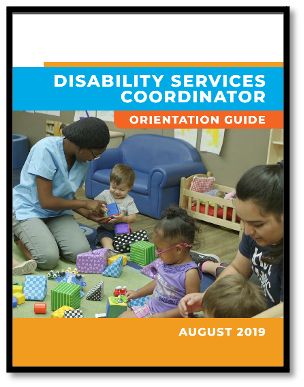
2019If you are new to the job, the Disability Services Coordinator Orientation Guide provides a foundation for your work. If you are seasoned, it can be used as a refresher course. You might be called an inclusion coordinator or disability/mental health coordinator. You may work under a support services manager, an education coordinator, or the program director. No matter your exact job title or your supervisor, you can learn from this guide.
Sections of the guide may be useful to other program staff, including program management, teachers, family advocates, and transportation and health specialists. Mental health consultants and school system staff also can find useful information. Some families may want to read about the processes involved and the service delivery for their children and for themselves. Your program's child care partners and other early childhood programs can use the guide, too.
For example, “Part II: Coordinated Services for Children with Disabilities and Their Families” is a roadmap of resources on inclusion on the Head Start ELKC website. You’ll find a framework for inclusion resources and additional guides to help you as a child care provider or family member who wants to understand inclusive services.
Added: Jan 2021
Head Start ECLKC: Services for Children Who Do Not Qualify for IDEA Fact SheetHead Start and Early Head Start programs need to serve children with disabilities who qualify for services under the Individuals with Disabilities Education Act (IDEA). However, programs also need to support children who may have delays in development or be at risk for disabilities, but don’t qualify for services under IDEA. This set of briefs is about the responsibilities Head Start and Early Head Start programs have related to providing additional services for children who are not eligible under IDEA, and how to support programs in doing so. It shares different options for plans that support children in classrooms, during group socializations, and during home visits. The last page of the document highlights what IDEA is and how eligibility is determined. This fact sheet describes laws and approaches to consider when deciding how to provide additional support to children who need it. It is a companion piece to
Services for Children Who Do Not Qualify for IDEA, which describes a disability services coordinator’s experience determining how to provide additional services to a child who is not eligible for IDEA services.
Added: Jan 2021
Head Start ECLKC: Universal Design for LearningHead Start ECLKCUniversal Design for Learning (UDL) is a framework for increasing access to education environments and opportunities, including in infant and toddler settings. Learning environments, materials, and activities are planned ahead of time, with the aim of welcoming all learners.
UDL supports all children, including infants and toddlers with disabilities, to help them engage more fully in learning. It doesn't take the place of individualized curriculum modifications necessary for particular children. For more information on individualized curriculum modifications, see these helpful Curriculum Modifications resources.
The three guiding principles of UDL are:
- Representation — offering children a variety of ways to learn new skills and information
- Action and expression — allowing for flexibility in how infants and toddlers demonstrate success and understanding
- Engagement — building on infant/toddler development and interests and giving them choices
On this web page Head Start gives you a place to start for designing your environments with UDL in mind with their “Tips for Educators” and provides links to additional resources to support UDL for infants, toddlers and preschoolers.
Added: Sep 2023
How People’s Misconceptions Of Disability Lead To Toxic Microaggressions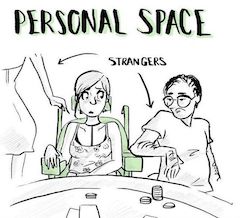
Feb 2019
In general, society and the media have two extremely polarizing views on people with disabilities. They are viewed as either remarkable and heroic or victims and pitiful. Since disability falls on a wide range of a spectrum, these stereotypes are very limiting and can lead to severe repercussions for the disabled community and their views of themselves. For the outside, able-bodied population, these biases cause them to set forth unconscious microaggression toward their peers with disabilities.
Added: Jul 2019 | Updated: Feb 2021
How to Include Students with Disabilities in General Education in 4 Easy StepsTim Villegas | June 4, 2021 "After I learned about the practical nuts-and-bolts of inclusive education (what it looked like), I found that the biggest barrier wasn’t that people didn’t know how to include students with disabilities. They didn’t think there was a problem with how we are educating disabled students in the first place.
As we have seen with other systemic issues in the world, if you deny a problem exists, it is difficult to change the system that perpetuates it."
This insightful article describes 4 pre-requisites to including kids with disabilities in the general education classrooms. The first step is to recognize that the problem is how we think about disability. Exploring the difference between the social model of disability and the medical model of disability helps to lay out the issues.
Added: Jun 2021
How to Make A One Page ProfileIn this blog post a mom of a preschooler with Down Syndrome explains how to make a one page info-graphic that displays her daughter’s strength’s, what works and what doesn’t work for her and what she is working on. This is a creative school friendly and other family friendly way to introduce a child with special needs to a new class room.
Added: Oct 2017 | Updated: Feb 2019
How We Do School (Video Series)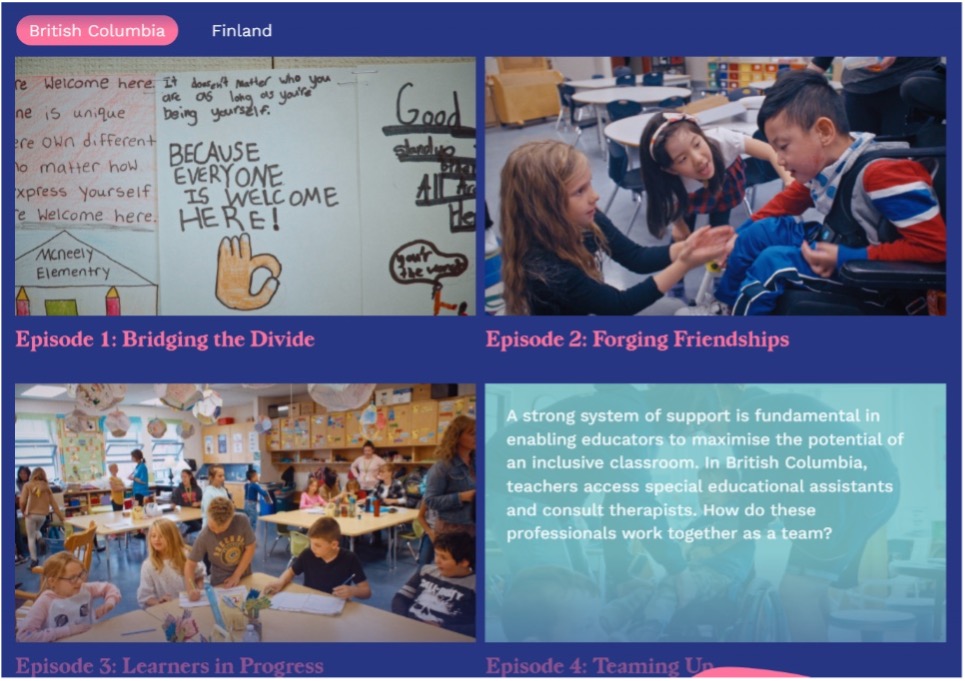
Inclusion MattersAn initiative of the Lien Foundation, How We Do School is a nine episode series of short films that explores how Finnish and British Columbia schools address the increasingly diverse learning needs of its students and what we can learn from them.
The Lien Foundation took two Singapore educators from the early childhood education and special education sectors – Dr Jacqueline Chung, Senior Principal and Academic Director at St James’ Church Kindergarten and Ms Tan Sze Wee, Executive Director at Rainbow Centre – to Finland and British Columbia to learn their journeys towards greater inclusivity and equity in its education system. By showing what is possible, we hope this can in turn inspire Singapore and inform ways that we can go about making inclusion more of a reality.
Added: Mar 2022
IEP Quick Tips: Reframing Weaknesses as Strengths and Needs (PDF)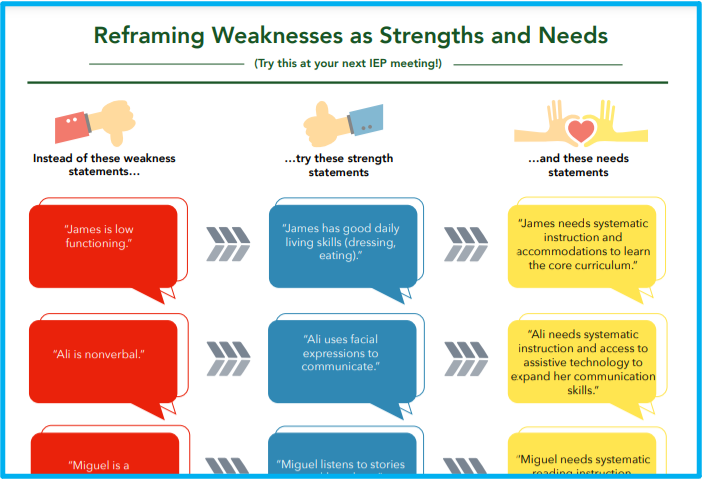
It’s true–getting “stuck” on a student’s challenges can make it tough to move forward with an effective IEP that meets his or her needs. Give this a try instead: flip those immobilizing “weakness statements” into specific strengths and needs statements that point the way toward solutions.
This graphic found in the link above gives you 5 great examples of what that sounds like. It was developed from Mary Falvey’s book Believe in my Child with Special Needs.
Added: Mar 2022
Including All ChildrenA brochure that provides information on the Americans with Disabilities Education Act and the Individuals with Disabilities Education Act as they relate to early childhood programs, plus a list of resources for technical information.
Added: Mar 2015 | Updated: Feb 2019
Inclusion Matters for All StudentsHuffington Post article discusses the Summary of Evidence on Inclusive Education above
Added: Feb 2017 | Updated: Feb 2019
Inclusion.comTogether We're Better. All Means All. Inclusion Means WITH - Not Just IN
Added: Mar 2015 | Updated: Feb 2019
Inclusive Schooling
Julie Causton, PhD and Kate MacLeod, M.S.Ed co-founded Inclusive Schooling in order to support administrators, educators and parents who wish to create more caring, creative inclusive schools for all learners. Inclusive Schooling offers live and online courses, workshops, presentations and innovative support focused on creating and supporting more inclusive schools.
-
Additional Resources from Inclusive Schooling
- Self-Care September 2019
Educators know that September can be a challenging month. It’s the first of the school year, and with the excitement, it also brings anxiety, stress, and difficulties as teachers, students, and administrators adjust to the “new normal.” One of the best things educators can do during this time is to promote your own health, happiness, and well-being with a daily practice of self-love and self-care.
- When Students are Labeled “Too Much” Aug 2019
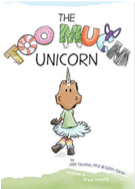 When students are labeled as “too much,” the response is often exclusion. When classrooms prioritize control of students behaviours and bodies, the students exhibiting behaviours we consider “challenging” or “too much” are too often separated, segregated, secluded from the classroom community. When we prioritize control in this way, we neglect connection. We deny our students, and ourselves, the opportunity to show up as our true selves.
When students are labeled as “too much,” the response is often exclusion. When classrooms prioritize control of students behaviours and bodies, the students exhibiting behaviours we consider “challenging” or “too much” are too often separated, segregated, secluded from the classroom community. When we prioritize control in this way, we neglect connection. We deny our students, and ourselves, the opportunity to show up as our true selves.
- Free Articles by Julie Causton
- Strategies for Success: Creating Inclusive Classrooms that Work (PDF)
- Webinar: 5 Steps for Creating More Inclusive Classrooms
Added: Sep 2016 | Updated: Jan 2021
Inclusive Schooling: Because of Oliver (Video)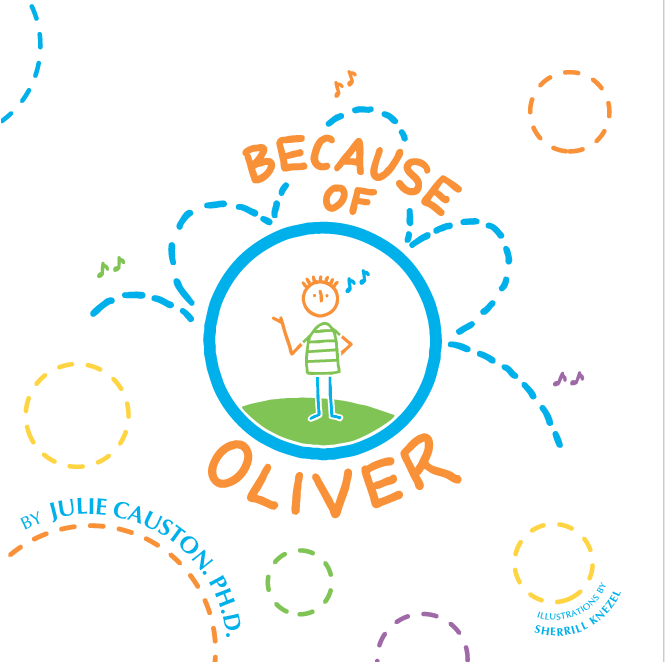
Inclusive Schooling | Length: 7:04 minsWhat Does Inclusive Education Look Like? Dr. Julie Causton of Inclusive Schooling shows you with the new book and video, “Because of Oliver.”
“Ever have a hard time explaining what inclusive education looks like at the classroom level? This book does a beautiful job of showing the reader the beauty of inclusive education.”
“Follow Oliver as he experiences school before and after inclusion- and how his story impacts everyone around him.”
You can hear Oliver's story and watch the video here, and get your own copy of the book on Amazon here.
Added: Jan 2021
Inclusive Schooling: Watch “Circle Makers” too! (Video)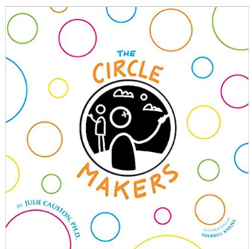
Inclusive Schooling | Length: 5:20 minsOur outdated school systems of drawing sharp lines, labeling and segregating students has never made sense. The first in a series, this book takes a playful look at what is possible when we think differently about human difference. Intended to inspire everyone to widen our school communities to finally and actually include all.
Added: Jan 2021
IRIS Training Module: Early Childhood Environments: Designing Effective ClassroomsThis Module offers information on how to set up effective inclusive early childhood classroom environments for young children. It also provides details about the interrelated physical, social, and temporal components of those environment, as well as adaptations to help teachers meet the needs of children with disabilities.
Added: Apr 2017 | Updated: Feb 2019
Kids Included Together (KIT)KIT stands for Kids Included Together, a registered 501(c)(3) non-profit organization that was founded in San Diego, California in 1997. The mission of Kids Included Together is to support recreational, child development, and youth development programs that include children with and without disabilities. KIT's goals are to enrich the lives of all who participate and to increase understanding and acceptance of disabilities as a natural part of life. We invite you to explore our site and learn more about our work in San Diego County and across the nation.
- Summer Camp Means Fun for All: How to Create a More Inclusive Camp May 20, 2022
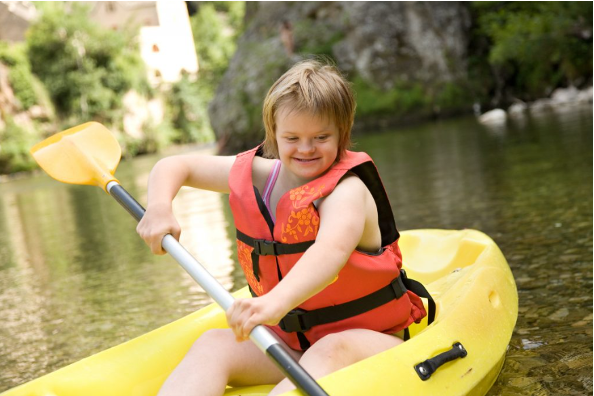 Kids Included Together (KIT) says, “Pinpointing exactly what it means and looks like to be inclusive can be tough because creating a sense of belonging for each child will differ from person to person and camp to camp. But, that’s really what it is – creating a sense of belonging for each camper.”
“So, where do you start and how do you know if you’ve gotten there? Well, providing a meaningful experience for every camper may look varied, but it will be rooted in a few universal principles.” This article provides helpful considerations to add to KIT’s inclusion checklist.
Kids Included Together (KIT) says, “Pinpointing exactly what it means and looks like to be inclusive can be tough because creating a sense of belonging for each child will differ from person to person and camp to camp. But, that’s really what it is – creating a sense of belonging for each camper.”
“So, where do you start and how do you know if you’ve gotten there? Well, providing a meaningful experience for every camper may look varied, but it will be rooted in a few universal principles.” This article provides helpful considerations to add to KIT’s inclusion checklist.
- Additional Resources from KIT
- KIT: Top 5 Trends in Disability Inclusion 2018 Sept 2018
Kids Included Together (KIT) is leading the field in disability inclusion and behavior support through work with over 450 organizations in the United States, Europe, Asia, and Australia. Using research, media, and recent KIT data from 625 training sessions, 100 online courses, 325 onsite visits, and 1,752 support center calls, we have identified the top 5 trends in childhood disability inclusion. In 2018, we can exploit these trends to help increase meaningful inclusion of children with disabilities in schools and communities.
- Inclusion Resources: Videos, Tip Sheets, Checklists, Guidebooks and Websites Sept 2018
- Who We Are-Our Work: Publications Sept 2018
- What is Inclusion? (PDF) Sept 2018
Added: Mar 2015 | Updated: Jul 2022
Least Restrictive EnvironmentsCenter for Parent Information and Resources | April 2022 “Least restrictive environment, or LRE as it is more commonly called, is one of several vital components in the development of a child’s IEP and plays a critical role, influencing where a child spends his or her time at school, how services are provided, and the relationships the child develops within the school and community. Indeed, LRE is a foundational element in building an appropriate IEP that can improve outcomes for a child—in school and in life.”
This webpage walks you through the legal definition of LRE, how placement decisions are made and parents rights. It’s available in English and Spanish.
Added: Jul 2022
Let’s Participate! Assistive Technology for Young ChildrenLet's Participate! is a model demonstration project designed to assist IDEA Part C and Part B preschool programs in implementing and sustaining promising practices in the effective use of assistive technology (AT) by infants, toddlers, and preschool children with disabilities and, as a result, improve their functional outcomes.
Added: Apr 2017 | Updated: Feb 2019
MCIE’s White Paper: Placement of Learners With Disabilities In the Least Restrictive Environment (PDF)Dr. Carol Quirk and Alice K. NelsonThis 21-page document goes through the history of the Individuals with Disabilities Education Act (including amendments to the law), a thorough explanation of the LRE, case law that supports inclusive placements, as well as calls-to-action for district and school leadership teams to transform their practices.
Added: Mar 2022
My STEM Adventure App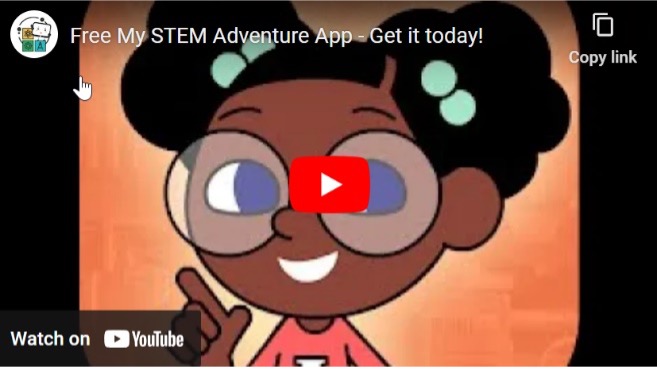
This free, teacher approved, award-winning app is for children with and without disabilities and their caregivers is in English and Spanish.
Join Leila Diaz as she guides young children and their families or other caregivers to explore the world of STEM both indoors and outdoors and create a storybook that details their investigation! As part of each of the 10 adventures, families and other caregivers are also able to learn about why the STEM concepts are important, what the children are learning, and also receive tips on how to guide children as they embark on the adventure together.
Added: May 2024
NAEYC Developmentally Appropriate Practice“NAEYC is excited to announce that the fourth edition of the Developmentally Appropriate Practice (DAP) position statement is now available. First published nearly 40 years ago, this foundational position statement is one of five created by NAEYC in collaboration with the early childhood profession. This edition of DAP reflects new research that—more extensively than in previous editions—ensures each piece of the position statement underscores the importance of social, cultural, and historical contexts of development and elevates the need for active engagement through play, exploration, and inquiry in ways that support the whole child.”
Added: Jan 2021
National Association for the Education of Young Children (NAEYC)
The National Association for the Education of Young Children (NAEYC) is the nation’s largest organization of early childhood professionals and others dedicated to improving the quality of early childhood education programs for children birth through age eight. NAEYC’s primary goals are to improve professional practice and working conditions in early childhood education and to build public understanding and support for high-quality early childhood programs.
-
Additional NAEYC Resources
Cultural Competency & Family Engagement
Healthy Mind, Health Body
Policy/Trends
- Public Policy Overview
NAEYC promotes national, state and local public policies that support a system of well-financed, high quality early childhood education programs in a range of settings, including child care centers, family child care homes, and schools.
Social-Emotional & Behavior
- Promoting Social–Emotional Development: Helping Infants Learn About Feelings (PDF)
Starting from birth, infants begin learning how to make sense of their world through interactions with caregivers. Responsive caregiving-which involves caregiver reflecting and validating a child’s feelings and behaviors-help very young children makes sense of their world. Over time, children who have this type of nurturing, reflective care better regulates their emotions.
- 10 Tips for Raising a Compassionate Toddler
Recent research shows that infants and toddlers are far more empathetic than we once thought. While they have short fuses, and don’t cope well with sharing, they are capable of being compassionate. With this in mind, here are ten tips I use in the classroom to help infants and toddlers become pro-social that families can also try at home.
- NAEYC Radio
NAEYC and BAM Radio Network partnered to bring NAEYC Radio. The program was developed to bring the best and latest insights on early childhood education directly to parents and educators.
- 10 tips for Raising a Compassionate Infant Toddler
- Helping Infants Learn About Feelings (PDF)
- Standing Together Against Suspension and Expulsion Joint Policy Statement (PDF)
A group of more than 30 national organizations recently published a joint statement, Standing Together Against Suspension and Expulsion in Early Childhood: A Joint Statement (April 2016), which supports the recommendations from the U.S. Departments of Education and Health and Human services in their December 2014 Joint Policy Statement on Expulsion and Suspension. The organizations have also compiled a number of related resources to help states, districts, communities, and classrooms prevent, limit, and ultimately eliminate suspension and expulsion in early childhood education.
- Caring Relationships: The Heart of Early Brain Development By Ron Lally and Peter Mangione
Added: Aug 2014 | Updated: Feb 2021
National Center on Accessible Educational MaterialsThis website was developed by a cooperative agreement between
CAST and the US Department of Education (IDEAs that Work). Accessible educational materials, or AEM, are materials and technologies usable for learning across the widest range of individual variability, regardless of format or features. Whether a material or technology is designed from the start to be accessible for all learners or is made accessible for learners with disabilities, it is considered AEM.
- Quick Starts
Organized by audience, each Quick Start offers brief answers to the most commonly asked questions about AEM along with links to additional resources for further information.
- Early Learning Resources
Added: Apr 2017 | Updated: Feb 2019
National Center on Universal Design for LearningFounded in 2009, the National UDL Center supports the effective implementation of UDL by connecting stakeholders in the field and providing resources and information about UDL basics, advocacy, implementation, research, community and research.
Added: Feb 2017 | Updated: Feb 2019
National Professional Development Center on Inclusion (NPDCI)The National Professional Development Center on Inclusion (NPDCI) is working with states to ensure that early childhood teachers are prepared to educate and care for young children with disabilities in settings with their typically developing peers.
-
Additional Resources from NPDCI
- Early Childhood Inclusion
Two major early childhood organizations, DEC and NAEYC, created a joint definition and position statement on early childhood inclusion through a process facilitated by the National Professional Development Center on Inclusion (NPDCI). Return here often to discover new resources and examples for using these resources to improve early childhood services.
- Foundations of Transition Video
Today, most families of young children use and move between different types of early childhood services -- like Head Start, private child care, public preschool, or kindergarten. Moving between and among these various programs is often referred to as ’transition’.” This 8-minute video provides an overview of the desirable outcomes of transition, research identifying effective transition practices, as well as the legal requirements of early childhood transition (running time: 8 min. 19 sec.)
- Speaking of Inclusion (Blog)
Inclusion insights, stories and resources for professional development providers as well as practitioners, policy makers and parents. An informative blog brought to you by the National Professional Development Center on Inclusion. Your comments are invited.
- Response to Intervention in Early Childhood (RTI-EC)
The NPCDI facilitated a process with The Division for Early Childhood of the Council for Exceptional Children (DEC), the National Association for the Education of Young Children (NAEYC), and the National Head Start Association (NHSA) to create a reliable source of information on the emerging practice of Response to Intervention in Early Childhood.
- Quality Inclusive Practices: Resources and Landing Pads
Provides brief descriptions and supporting references for evidence-based and promising practices that support early childhood inclusion.
- Building Inclusive Child Care
Universal Design for Learning rom North Hampton Community College
Added: Aug 2014 | Updated: Mar 2019
Natural Resources Monthly ResourcesSCRIPT - University of North Carolina | Camille CatlettSubscribe to this monthly newsletter from an expert in early childhood inclusion to get free resources on a variety of topics. Example topics include:
Added: Jun 2021
ParaEducate BlogStrategies for para-educators in inclusive classrooms.
Added: Sep 2016 | Updated: Feb 2019
PEAT’s Suite Online: Self-Guided Module: Physical Environment and Assistive Tools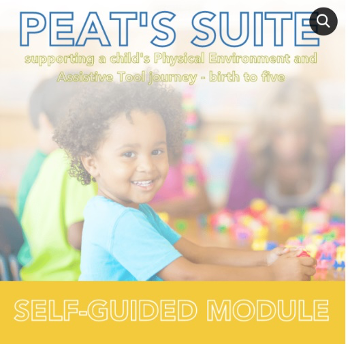
Connect Modules & DECAccess this learning module for PEAT’s Suite to explore and practice using environmental features, as well as universal, modified and specialized assistive tools.
NOTE: The module at this link is FREE. If you would like a PD certificate of completion for the module ($10 per certificate), please start here instead.
About PEAT’s Suite: PEAT’s Suite, created by Suzanne A. Milbourne and originally published in 2018, is a comprehensive package of materials that helps service providers (educators, home visitors, therapists, etc.), families, and other stakeholders support the participation of young children with differing abilities in typical routines and activities. The acronym PEAT stands for Physical Environment and Assistive Tools.
Added: Feb 2021
People First Language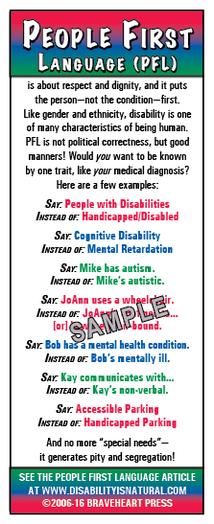
For too long, people who happen to have conditions we call "disabilities" have been subjected to devaluation, marginalization, prejudice, and more. And the first way to devalue someone is through language, by using words or labels to identify a person/group as "less-than," as "the other," "not like us," and so forth. Once a person/group has been identified this way, it makes it easier to justify prejudice and discrimination. Our language shapes our attitudes; our attitudes shape our language; they're intertwined. And our attitudes and language drive our actions!
- See the article by Kathy Snow, The Case Against “Special Needs” for a discussion about how those terms have been used and why we might not want to use them in the futures.
- People First Language (PDF)
That old "sticks and stones" saying is wrong: words are powerful and they can hurt! Other civil rights movements generated changes toward more respectful and accurate language and attitudes; the Disability Rights Movement is doing the same, beginning with People First Language. (This is the 4-page version, with examples.)
Added: Jul 2016 | Updated: Jul 2019
Position Statement of Multi-Tiered Systems of Support Framework in Early Childhood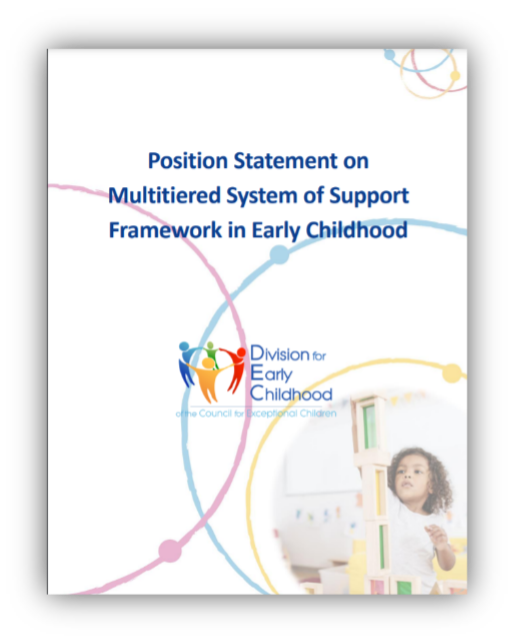
Division for Early Childhood (DEC) | September 17, 2021This position statement replaces the 2013 Frameworks for Response to Intervention in Early Childhood: Description and Implications.
The purpose of the revised statement is to define an early childhood multitiered system of support (MTSS) framework and to promote a broader understanding and discussion of the implications for young children, their families, and those who serve them.
The guidelines provided in this position statement are useful to programs seeking to implement the broad principles and elements of an MTSS framework. Specifically, programs can ensure that young children are being universally screened, authentically assessed, and differentially supported in ways that are developmentally appropriate and address their unique needs across both curricular and developmental outcomes.
Added: Oct 2021
Position Statement on Inclusion (PDF)DEC and the National Association for the Education of Young Children (NAEYC) developed a joint position statement on early childhood inclusion (April 2009).
Division for Early Childhood (DEC).
Added: Mar 2015 | Updated: Feb 2019
Program for Infant Toddler Care (PITC) Six Essential Program PracticesThis series helps promote essential program practices to ensure quality within family child care and center-based programs that serve infants and toddlers. It addresses the following topics:
- Continuity of care
- Culturally sensitive care
- Inclusion
- Individualized care
- Primary care
- Small groups
Added: Oct 2017 | Updated: Feb 2019
Quality Indicators of Inclusive Early Childhood Programs/Practices: A Compilation of Selected Resources (PDF)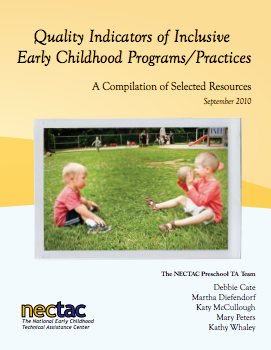
Published: 2010
Available resources and indicators of high quality inclusive practices are presented in this compilation. Assembling many different resources in one place allows for easy comparison of potential indicators of quality. Excerpts and adaptations of the resources are intended to provide some familiarity with the content of each resource and encourage further examination via links to more complete information. National and state-developed resources contained within this document have been designed for a variety of audiences, and may be useful for families, practitioners, program administrators, technical assistance personnel, researchers, and state administrators.
Added: Jul 2016 | Updated: Feb 2019
Quote from Nicole Eredics
Brookes Publishing“Inclusion begins by saying, yes, we will educate every child.”
Added: Jun 2023
Recommendations to Promote High-Quality Inclusion for Infants and Toddlers with Disabilities (PDF)Zero to Three | July 2022Recently published in the ZERO TO THREE journal, this document calls on federal and state-level policy makers and program leaders to purposefully consider the needs of our nation’s youngest children with disabilities and/or delays when making funding and policy decisions for early childhood care, education, support, and intervention. Read this, discuss this, and consider the importance of these ideas in your own work
Added: Jul 2022
Reimagining Special Education – Using Inclusion as a Framework to Build Equity and Support All Students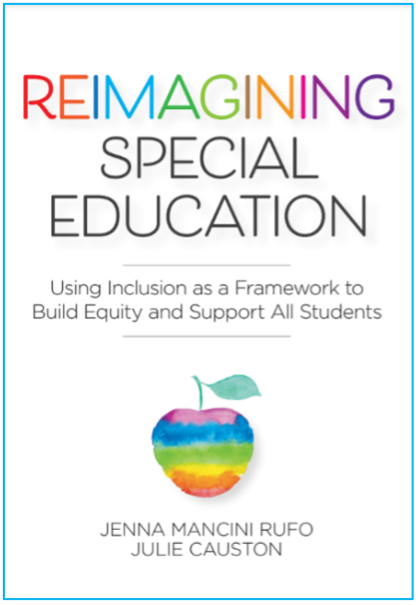
Brookes Publishing | 2021A visionary call to action from inclusion experts Jenna Mancini Rufo and Julie Causton, Reimagining Special Education guides readers in creating more equitable schools and services, through practical strategies teachers can use right away and thought-provoking, big-picture questions for administrators to tackle. Readers will explore how inclusive educational practices can address each student’s unique needs as schools reopen and bridge learning gaps for students who struggle.
Read Chapter 1, Resetting School: Lessons Learned from COVID-19 Remote Instruction (free excerpt below). The author discusses the impact of COVID-19 on an already inequitable system and reviews the most effective practices that emerged, practices that benefit all students.
Added: Oct 2021
Research on the Efficacy of Inclusive Education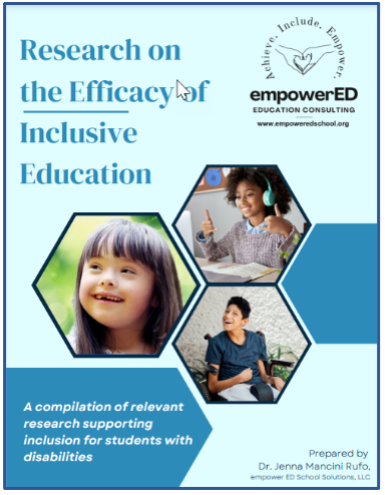
empowerEd School Solutions“Arm yourself with a summary of the research on inclusive education.” This 11 page brief prepared by Dr. Jenny Mancini Ruffo sites a base of research spanning over 40 years, comparison studies, research on students with complex support needs, and students without disabilities educated with children with disabilities. The research documents evidence supporting the clear benefits of inclusive education for children with and without disabilities.
Added: May 2024
Response to Intervention in Early Childhood (RTI-EC)In a matter of a few short years, RTI has become a familiar phrase in the early childhood field. Because RTI is an emerging practice, it is critical that the early childhood field has a reliable source of information as programs begin to define and implement these practices. Three national organizations are working to provide this guidance. The Division for Early Childhood of the Council for Exceptional Children (DEC), the National Association for the Education of Young Children (NAEYC), and the National Head Start Association (NHSA) are working together to develop a joint position statement on RTI in early childhood. The National Professional Development Center on Inclusion (NPDCI) is helping to facilitate the process.
Added: Mar 2015 | Updated: Feb 2019
Rethinking Assistive TechnologyFeb 2019
If AT can be so beneficial and crucial to student learning, why are educators and school teams sometimes hesitant to use it in the classroom? It’s possible that the answer lies in misunderstandings about what assistive technology is and how it functions in education.
Added: Jul 2019
Rocking and Rolling: Promoting Inclusion in Infant and Toddler Settings
NAEYC - Young Children | Winter 2021“While inclusion is an important goal for many families and teachers and is a hallmark of a high-quality early learning program (DEC/NAEYC 2009; NAEYC 2020), effective implementation requires planning, intentionality, and collaboration.”
This article provides a succinct overview of inclusion for infants and toddlers. It explains why you should prioritize inclusion, describes the key features of inclusion (access, participation and support) and provides strategies in planning for inclusion.
Added: Mar 2022
Say “Yes!” to Kids with Disabilities: Stories and Strategies for Including All Kids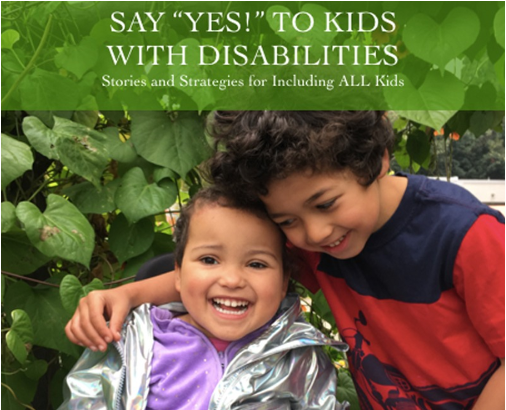
Seattle Children’s PlayGarden This guide, created by Seattle Children’s PlayGarden with King County Public Health’s Best Start for Kids Initiative, is a very thoughtful, respectful tool kit intended to open hearts, minds and access to play grounds, sports, after school activities, summer camps, art programs and other recreational programs to children with disabilities. Readers are given an opportunity to reflect on what they’ve experienced as they read the stories and strategies with questions following each section. Child care providers, preschool teachers, families and anyone who works with children will enjoy this tool kit. Start at the beginning! You don’t want to miss the orientation to the book or the introduction.
“In this toolkit you will not see a list of the “benefits of inclusion.” We are beyond having to justify what is a basic human right of all children: the right to play. Every child’s right to play is a fundamental human right as enshrined in article 31 of the United Nations Convention on the Rights of the Child (International Play Association, 2018). Instead, what you will find here are stories - stories from parents, youth service organizations, and from children themselves. Through these stories, we learn about the barriers to participation and what has worked to break down these barriers.”
Added: Jul 2022
Seeds of Partnership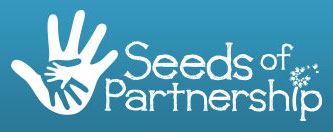
Seeds of Partnership provides assistance on behalf of the California Department of Education (CDE) to support the direction, initiatives and focused goals related to requirements of the Individuals with Disabilities Education Act (IDEA), federal reporting/monitoring activities, State Performance Plan (SPP) and Results Driven Accountability initiatives. A mainstay of the project focus is on parent and family engagement in education.
- High Quality Early Learning Environment (HQELE)
This comprehensive panoramic virtual tour emphasizes principles of a quality classroom design and incorporates key strategies on how to replicate highlighted elements. Early Childhood Special Education teachers, General Education teachers, and administrators are always looking to enhance their classroom environments to support all students. This tool provides the opportunity to gain valuable ideas to build upon existing philosophical and program practices, wherever a program or classroom may be on the Least Restrictive Environment continuum.
Added: Sep 2016 | Updated: Feb 2019
Setting Up a Disability-Inclusive Curriculum: Six strategies for making people with disabilities a part of your students’ diverse learning experiencesEdutopia | January 20, 2022 “As a person with a disability, I (Nikhil) have grown up surrounded by nondisabled figures in the media and in my daily life. As I get closer to reaching adulthood, I’ve become increasingly aware of the lack of representation of people like me who live with disability every day. While schools make accommodations to the physical environment and instructional approach to help students with disabilities learn and grow, the actual curriculum, the “what students learn,” is often silent about disability and the contributions of individuals with disabilities.”
“Because of the silence in our schools about disability, I’ve made it my mission to make the world a better place by increasing awareness about disability and shedding light on what it means to live the way I and other people with disabilities live.”
Added: Mar 2022 | Updated: Aug 2023
Sibling Support ProjectFounded in 1990, the Sibling Support Project is the first national program dedicated to the life-long and ever-changing concerns of millions of brothers and sisters of people with special health, developmental, and mental health concerns.
We’ve published
books for and about brothers and sisters,
host online groups for teen and adult siblings, and presented
workshops on sibling issues internationally and in every state.
However, we’re best known for helping local communities start
Sibshops—lively peer support groups for school-age brothers and sisters of kids with special needs.
Added: Mar 2015 | Updated: Feb 2019
SpecialQuest Multimedia Training Library
The SpecialQuest Multimedia Training Library is an easy–to–use, comprehensive training curriculum for individuals working with young children who have disabilities, birth–five, and their families. The Library is designed for use in a variety of professional development settings.
Added: Mar 2015 | Updated: Feb 2019
STEMIE Learning TrajectoriesSTEMIE (Innovations for Inclusion in Early Education) and Learning and Teaching with Learning Trajectories collaborated with early STEM incubators to develop and refine the learning trajectories for science, technology, engineering, and math. What is that? Visit the website, watch the video and learn more. Inclusion Facilitators will be interested in the Guide to Adaptations (PDF). It includes a framework for adaptations to the environment, materials and instruction.
Added: May 2024
STEMIE: A Guide to Adaptations (PDF)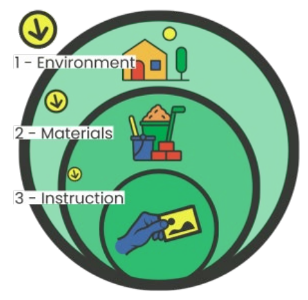
At STEMIE, we use adaptations to ensure each and every child, including young children with disabilities can fully participate and engage in STEM (science, technology, engineering, and math) learning opportunities and experiences at home, in early childhood programs, and in the community. However, some young children may require additional instructional supports from adults and/or peers to successfully engage in STEM learning opportunities and experiences. For more information and strategies see STEMIE’s A Guide To Teaching Practices (PDF)
Added: Jul 2022
STEMIE: A Guide to Teaching Practices (PDF)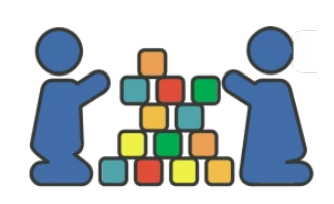
StemieIn this document, we define and describe evidence-based teaching strategies, as well as provide examples of each teaching strategy that adults may use to ensure young children with disabilities can participate fully in STEM learning experiences.
What are teaching strategies? Teaching strategies are practices used by adults (e.g., family members, practitioners) or, in some instances, by other children to help facilitate children’s participation in everyday routines, learning experiences, and activities. Using these strategies engages children in activities, maintains their interest, and provides opportunities for them to learn concepts and thinking skills that support STEM learning when using adaptations (see STEMIE’s A Guide to Adaptations for more information) is not a sufficient support.
Added: Jul 2022
Step Up AT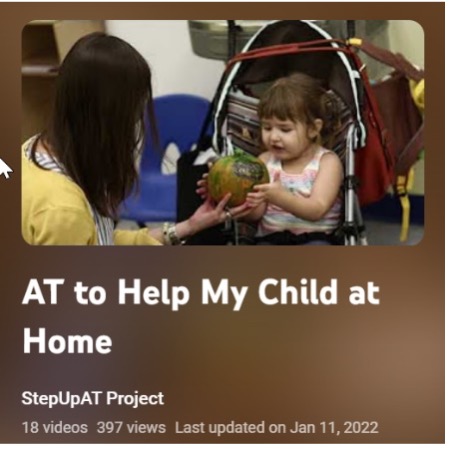
Step Up AT coaches teachers, teacher assistants, teacher support specialists, school districts, and other agencies to adopt evidence-based assistive technology (AT) practices. This evidence-based, customizable program helps improve early literacy outcomes for young children (ages 3-5) who have disabilities. It is recommended by the federal Early Childhood Technical Assistance (ECTA).
Additional videos are available on the Step Up AT YouTube Channel.
Added: May 2024
Summary of the Evidence on Inclusive Education (PDF)December 2016
In this report we sought to identify research that demonstrates the benefits of inclusive education not only for students with disabilities, but especially for students without disabilities, since evidence of benefits for the former is already widely known. This report is the result of a systematic review of 280 studies from 25 countries. Eighty-nine of the studies provide relevant scientific evidence and were synthesized and summarized below.
Added: Feb 2017 | Updated: Feb 2019
Supporting Inclusive Practices (SIP) Project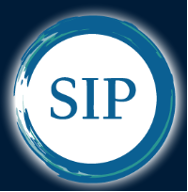
Supporting Inclusive Practices (SIP) Project, funded by the California Department of Education, supports LEAs in their inclusion efforts with their youngest learners, specifically students of color. This innovative project includes working alongside sample site LEAs throughout California to collect classroom walkthrough data as evidence of best practices centered on culturally responsive pedagogy and universal design for learning. The website is full of great resources. See:
- Universal Prekindergarten Inclusion Resources For resources and best practices for preschool placement in the least restrictive environment, social-emotional learning, and equitable disciplinary practices.
- Supporting Inclusive Practices (SIP) Archived Virtual Events web page provides a wealth of recorded trainings, podcasts, webinars, and other resources including content on Universal Design for Learning, equity in special education, designing inclusive preschools, a paraeducator series, and more.
- Special EDge Newsletter is focused on supporting and informing parents, educators, service providers and policy makers on research informed and promising practices, state and federal laws and policies and successes and challenges of educational partners as they work to improve education for students with disabilities in California.
Added: Jul 2022
Talking is Teaching: Talk, Read, Sing
"Talking is Teaching: Talk, Read, Sing" is a campaign of Too Small to Fail in partnership with various organizations that are dedicated to improving early childhood development. It offers the free downloadable
Sesame Street Family Guide: Talking is Teaching available in English and Spanish. It helps caregivers and parents fill each day with words, stories, songs … and love. Inside are tips and activities around talking, reading and singing with children and Milestone Cards to use as the child grows.
Added: Mar 2015 | Updated: Feb 2019
Tapping Into the 5 Senses to Support Students with Disabilities (and all students!)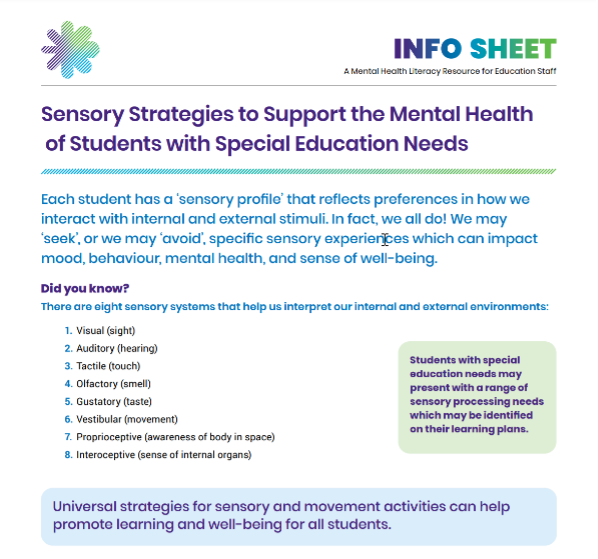
Edutopia | November 2023Our ability to smell, taste, hear, touch, and see plays an essential part in our everyday lives. These senses help us interpret thoughts and feelings about our surrounding environment and contribute to well-being. In the classroom, when students understand how to address each sense, they are more aware of what’s happening around them and within their body and mind.
The article describes 8 strategies to incorporate senses into the classroom and sites this article, Sensory Strategies to Support the Mental Health of Students with Special Education Needs (PDF), that explains universal strategies for sensory and movement activities can help promote learning and well-being for all students.
Added: May 2024
TASHTASH supports the inclusion and full participation of children and adults with disabilities in all aspects of their communities as determined by personalized visions of quality of life.
Added: Mar 2015 | Updated: Feb 2019
The Genius of PlayIt’s more than play! Through play, kids learn valuable skills they’ll use for a lifetime. The Genius of Play is your one-stop source for play ideas that build on these skills (with little to no prep time), expert advice and insights and the latest research on the value of play.
Added: Oct 2017 | Updated: Feb 2019
The Inclusive ClassInclusive Strategies and Solutions from a Classroom Teacher
Added: Mar 2015 | Updated: Aug 2019
The Preschool Inclusion Tool Box: How to Build and Lead a High Quality Program (Amazon Link)Published: 2015 Erin E. Barton Ph.D. (Author), Barbara J. Smith Ph.D. (Author), Christina L. Salisbury Ph.D. (Foreword)
Inclusion is clearly related to better outcomes for young children—but reports from the US Department of Education show the practice has grown by just 5% over the past 27 years. This is the how-to book preschool administrators, school district leaders, child care directors, and faculty need to step up the progress of early childhood inclusion through big-picture, systems-level change.
Shaped by feedback from a nationwide survey of IDEA Part B Preschool Coordinators and local school district leaders who shared their real-life inclusion challenges, this is your comprehensive toolbox of problem-solving tips, evidence-based practices, and practical checklists and handouts. You'll learn how to overcome the challenges to a high-quality inclusive preschool program, and you'll create a solid action plan for building and maintaining a successful program where all children learn and grow together.
Added: Sep 2016 | Updated: Feb 2019
The Segregation of Students with Disabilities (PDF)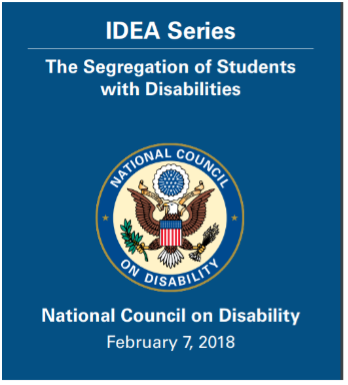
National Council on DisabilityThis report describes the legal and scientific basis for an inclusive versus segregated education, summarizes national patterns for educating students with disabilities in general education classes, examines federal and state guidance, and state compliance with federal mandates, describes effective educational practices for reducing segregation, and provides findings and recommendations for improvement. It is part of the Individuals with Disabilities Education Act Report Series (5 Report Briefs), National Council on Disability, February 7, 2018.
Added: Jul 2022
The Truth About Diversity in Schools (Video)February 9, 2024, | Length: 12:03 minsIn this recording, Dr. Kristie Pretti-Frontczak discusses why presuming competence is necessary to address the diversity of the modern classroom, how our intentions can lead to ableist practices, why the dominant culture perpetuates ableist practices and exclusion vs. inclusion, and how to move away from a medical model.
Added: May 2024
Think InclusiveWhere education meets advocacy…
Added: Mar 2015 | Updated: Jan 2021
Think Inclusive, the PodcastThe Think Inclusive Podcast (presented by MCIE) exists to build bridges between families, educators, and disability rights advocates to create a shared understanding of inclusive education and what inclusion looks like in the real world. Check out these two sample podcasts:
Added: Oct 2021
Think Inclusive: Four Children’s Books About Empathy That Shows That Everyone Matters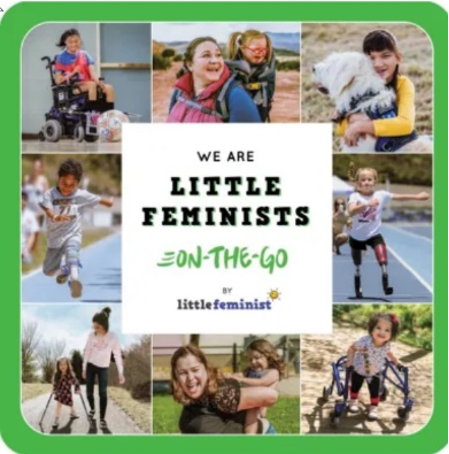
Think Inclusive | May 2020“Unfortunately, children often experience a lack of empathy for their differences, both among their peers and among the adults in their lives. Empathy is a learned skill; it can, and should, be taught. These four children’s books about empathy are excellent ways to introduce empathy skills and an appreciation for everyone’s differences.”
My favorite of the recommendations is actually a set of three board books that feature gorgeous photographs of inclusive families and children of all types and abilities. “The Families book portrays LGBTQ+ families, grandparents, and families of many races. Hair celebrates all the various shapes and places and ways hair can be. On-the-Go, pictured here, is a powerful visual celebration of all the ways our bodies can move, and all the different apparatuses that can get us there. At only 14 pages each, and just the right size for tiny hands, these books are great for toddlers and preschool classrooms. On-the-Go can also be paired with this diverse abilities figure set to extend the visual normalization of disability through play. Teaching acceptance and empathy can begin at any age, and the best way to begin for babies and toddlers is through exposure.”
Added: Jan 2021
Understanding Inclusion Training Modules for Families and Caregivers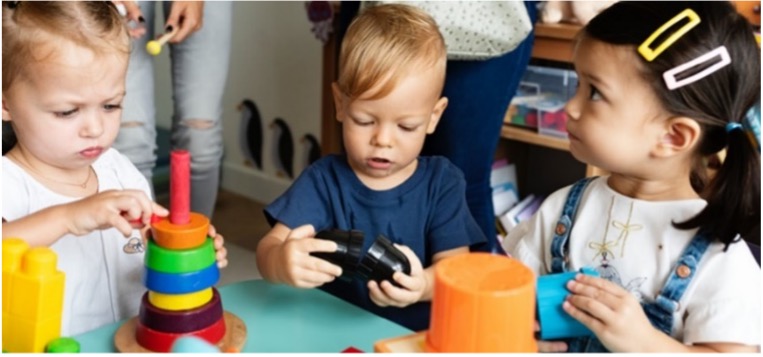
- Presented by: Early Choices
- Date: February 2021
- Language: Available in English and Spanish
The Understanding Inclusion series contains 6 topics that explore key ideas about inclusion in early childhood. The series covers a range of topics from defining inclusion to understanding the benefits to advocating for inclusion. This is a series of bite-size videos with embedded resources and activities to help understand, promote, and advocate for inclusion for children birth to age 5. Developed for families with family input, it is just as meaningful and useful for practitioners working with families who have children from birth to 5.
In each module topic, a topic guide is available for reflecting and applying what you learn to your own experience. The guide also has additional resources to explore the topic further.
We hope this series supports you on your journey of inclusion and provides you with resources that you can share and build upon.
Added: Jun 2021 | Updated: Sep 2023
UnderstoodParents want the best for their children. We do, too. For the first time ever, 15 nonprofit organizations have joined forces to support parents of the one in five children with learning and attention issues throughout their journey.
With the right support, parents can help children unlock their strengths and reach their full potential. With state-of-the-art technology, personalized resources, free daily access to experts, a secure online community, practical tips and more, Understood aims to be that support.
Added: Jul 2018 | Updated: Jul 2019
Universal Design for Learning in the Early Childhood Classroom: Teaching Children of all Languages, Cultures and Abilities, Birth – 8 Years (Amazon Link)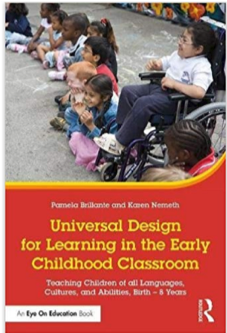
This book by Pamela Brillante and Karen Nemeth, published in 2018, focuses on proactively designing PreK through Grade 3 classroom environments, instruction, and assessments that are flexible enough to ensure that teachers can accommodate the needs of all the students in their classrooms. Typically developing students, gifted students, students who are impacted by poverty, children who speak multiple languages or have a home language that is different than the classroom language, and students with identified or potential developmental or learning disabilities are all covered within this highly practical, easy-to-use guide to UDL in the early years. Publication is available from Amazon.com
Added: Oct 2018 | Updated: Feb 2019
Zero to Three
Zero to Three is a national, nonprofit organization dedicated solely to advancing the healthy development of babies and young children. Zero to Three disseminates key developmental information, trains providers, promotes model approaches and standards of practice, and works to increase public awareness about the significance of the first three years of life.
-
Additional Resources from Zero to Three
Early Identification
Family Engagement
Inclusive Practice
- Beyond the Word Gap: Multimedia Resources and Tools
The "Word Gap" has come to symbolize the gulf that can separate very young children who have rich opportunities for positive early learning experiences from those who do not. Science reveals that early language and literacy skills are important predictors of later success in school—and that as a group, children in families of lower socioeconomic means have fewer skills and know far fewer words than their more privileged peers. This new web portal holds apps, videos, curriculum, research and other resources to enrich early learning experiences for all children.
- ZERO TO THREE has developed and released a new, free app called Let's Play!, which provides parents and grandparents with fun ideas for keeping babies and toddlers entertained and learning, especially during daily routines. Parents can search activities by age, share activities via social media, and tag their favorites.
- Resources for Families: The "Missing" First Year
Policy/Trends
- Public Policy Center
A research based, nonpartisan program that brings the voices of babies and toddlers to public policy. They offer the opportunity to join the Public Policy Network and the e-newsletter, The Baby Monitor.
Social-Emotional & Behavior
- Challenging Behavior Resources
- Early Childhood Mental Health
Babies and young children thrive when they are cared for by adults that are “crazy about them!” (Bronfenbrenner, 1976 1). Responsive relationships with consistent primary caregivers help build positive attachments that support healthy social-emotional development. These relationships form the foundation of mental health for infants, toddlers and preschoolers. This site directs you to resources supporting healthy social emotional development of very young children.
- Baby Brain Map
The Brain Map was adapted in 2006 by ZERO TO THREE from BrainWonders, a collaborative project (1998-2001) between Boston University School of Medicine, Erikson Institute and ZERO TO THREE.
- Cope After Exposure to a Traumatic Event
Added: Oct 2014 | Updated: Feb 2019
25 Examples of Ableism to Avoid as an Ally to People With DisabilitiesJanuary 2020Ableism means “discrimination in favor of able-bodied people.” Since
at least one out of five people will become disabled in their lives — and ableism is still largely unaddressed and unknown — if you are the loved one of someone with a disability, you will want to be aware of how to proceed with compassion. Here is a list of 25 examples of ableism so you can be a good friend/medical practitioner/family member and
avoid the harm ableism causes.
Added: Jan 2021
Demystifying Disability: What to Know, What to Say and How to be an Ally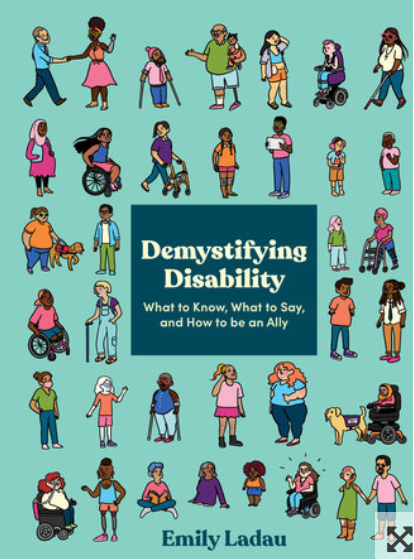
Author: Emily LadauABOUT DEMYSTIFYING DISABILITY
An approachable guide to being a thoughtful, informed ally to disabled people, with actionable steps for what to say and do (and what not to do) and how you can help make the world a more accessible, inclusive place.
Disabled people are the world’s largest minority, an estimated 15 percent of the global population. But many of us–disabled and non-disabled alike–don’t know how to act, what to say, or how to be an ally to the disability community. Demystifying Disability is a friendly handbook on important disability issues you need to know about, including:
- How to appreciate disability history and identity
- How to recognize and avoid ableism (discrimination toward disabled people)
- How to be mindful of good disability etiquette
- How to appropriately think, talk, and ask about disability
- How to ensure accessibility becomes your standard practice, from everyday communication to planning special events
- How to identify and speak up about disability stereotypes in media
Authored by celebrated disability rights advocate, speaker, and writer Emily Ladau, this practical, intersectional guide offers all readers a welcoming place to understand disability as part of the human experience.
Added: Jun 2021
The Do’s and Don’ts of Disability (Video)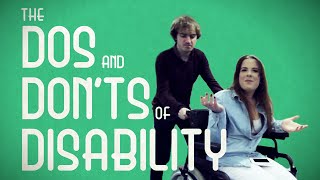
UK Fixers | January 2016 | Length: 3:24 minutesIn this film, Michelle Middleton takes a humorous look at people's reactions to her cerebral palsy. The 26-year-old has created the piece, with the help of Fixers, to encourage others not to treat her, or anyone else with a disability, differently.
Added: Jun 2023
Eight Reasons Why I No Longer Use the Term “Special Needs”Jan 2019
We are all at different points on our journey and learning and language and vernacular is constantly changing. I will always continue to call people what they prefer to be called. For now, because I am not disabled, I am going to follow their lead, as we all should do.
Added: Jul 2019
Guidelines for Writing About People with Disabilities (from the ADA National Network)The words you use and the way you portray individuals with disabilities matters. This factsheet, from the ADA Network.gov provides guidelines for portraying individuals with disabilities in a respectful and balanced way by using language that is accurate, neutral and objective.
Added: Jul 2019
Not Special Needs, Just Human NeedsSee the video and discussion about why. Sure, people with Down syndrome may need extra assistance. Sometimes they even need significant assistance, and adjustments, to meet a particular need. But that doesn't make that common human need “special.”
Added: Jul 2019
OllibeanOllibean is a dynamic community of parents, families and advocates in the disability community working together for a more socially just, accessible and inclusive world.
Read the Blog posts by Amy Sequenzia, a non-verbal autistic, as she refers to herself, to learn about the life and culture of a person who is proud to be autistic.
Added: Jul 2019
People First Language
For too long, people who happen to have conditions we call "disabilities" have been subjected to devaluation, marginalization, prejudice, and more. And the first way to devalue someone is through language, by using words or labels to identify a person/group as "less-than," as "the other," "not like us," and so forth. Once a person/group has been identified this way, it makes it easier to justify prejudice and discrimination. Our language shapes our attitudes; our attitudes shape our language; they're intertwined. And our attitudes and language drive our actions!
- See the article by Kathy Snow, The Case Against “Special Needs” for a discussion about how those terms have been used and why we might not want to use them in the futures.
- People First Language (PDF)
That old "sticks and stones" saying is wrong: words are powerful and they can hurt! Other civil rights movements generated changes toward more respectful and accurate language and attitudes; the Disability Rights Movement is doing the same, beginning with People First Language. (This is the 4-page version, with examples.)
Added: Jul 2016 | Updated: Jul 2019
Promoting Neurodiversity in Early Childhood Services (PDF)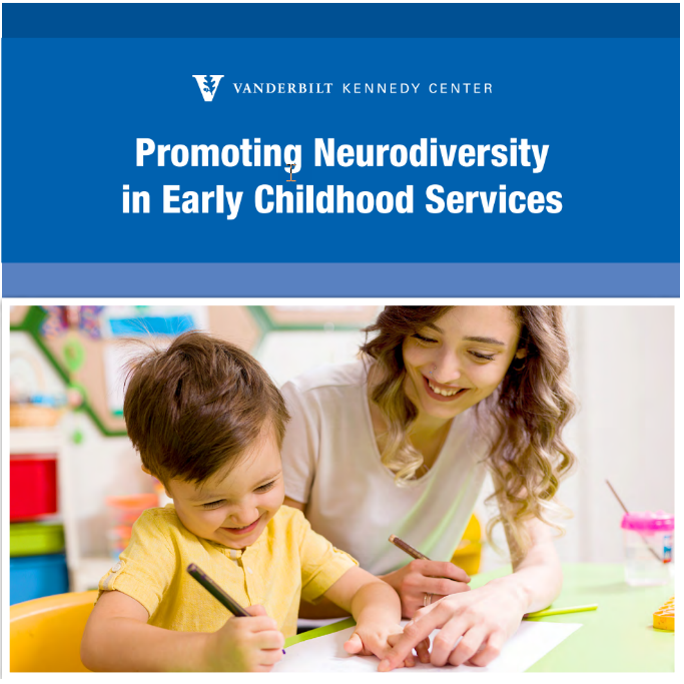
Vanderbilt Kennedy CenterThis pamphlet is intended for early childhood care providers who want to learn more about how to promote neurodiversity in early childhood. This could include early interventionists, developmental specialists, speech and language pathologists, occupational therapists, behavior analysts, preschool teachers, and anyone else who provides services to young autistic children and children with developmental disabilities.
Added: Jun 2023 | Updated: May 2024
Rosa’s Law Ended the Use of “Mental Retardation” in US federal law 5:19“Some say we shouldn’t worry about the words, just the way we treat people. But if you think about it, what you call people is how you treat people. If we change the words, maybe it’ll be the start of a new attitude towards people with intellectual disabilities. And they deserve it.”
In 2010, President Barack Obama signed “Rosa’s Law” which changed “mental retardation” to “intellectual disability” in US federal law. Inspired by nine year-old Rosa Marcellino, the law was a key component in the groundswell of advocacy efforts promoting inclusive, people first language for people with intellectual disabilities.
One such effort to end the hurtful use of the “R-word” is the “Spread the Word to End the Word” campaign, launched in 2009, inspiring over 1,000,000 people to sign the pledge to end the R-word. Ten years later, Spread the Word to End the Word is becoming Spread the Word: Inclusion, focusing beyond one word and creating a new reality of inclusion for all people with intellectual and developmental disabilities.
Added: Jul 2019
“Special needs” is an ineffective euphemism, Cognitive Research: Principles and ImplicationsPublished: Dec 2016
(Excerpt from Abstract) Although euphemisms are intended to put a more positive spin on the words they replace, some euphemisms are ineffective. Our study examined the effectiveness of a popular euphemism for persons with disabilities, special needs. Most style guides prescribe against using the euphemism special needs and recommend instead using the non-euphemized term disability; disability advocates argue adamantly against the euphemism special needs, which they find offensive. In contrast, many parents of children with disabilities prefer to use special needs rather than disability. This empirical study examined whether special needs is more or less positive than the term it replaces. The study predicted and observed that persons are viewed more negatively when described as having special needs than when described as having a disability or having a certain disability, indicating that special needs is an ineffective euphemism. These findings recommend against using the euphemism special needs.
Added: Jul 2019
Spread the Word: InclusionCo-founders of Spread the Word, Soeren Palumbo and Tim Shriver, Jr. talk about the growth of Spread the Word to a global effort for inclusion.
Added: Jul 2019
Talking About Disability: Why the Words We Choose MatterJan 2019
Disability is a facet of humanity, and as such, the language people choose to use to capture it can be as varied and diverse as the people who embody it. Generally speaking, there are two main schools of thought in disability lexicon: person-first language and identity-first language.
Added: Jul 2019
Terminology Matters- Language That Respects Individuals with Disabilities (PDF)Mary Ann Shaw | June 2021In this PowerPoint Mary Ann Shaw, full time faculty member at Saint Francis University, provides an engaging summary of what to say and what not to say when talking about individuals with disabilities.
Added: Jun 2023
They Use Person First Language and Forget Our HumanityThis Blog post is about disability language and autism. It is written by Amy Sequenzia, a nonverbal autistic (as she requests to be called).
Added: Jul 2019
We Need to Talk About Ableism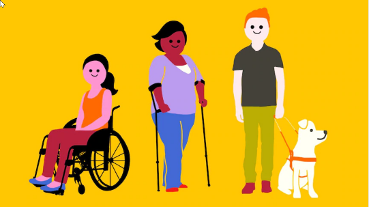
Ableism is the favoring of able neurotypical people, and the exclusion and devaluation of people who are disabled and neurodivergent.
Ableism may not be intentional (in the same way that racism or sexism may not be intentional) but that doesn't mean it's not harmful.
Take the many media stories that often use words that communicate the underlying message we are a "burden" on society.
Added: Jan 2021 | Updated: Mar 2021
When Is It Okay to Use the R-Word? (Video)
Published: Apr 2015 | 3:48 minutes
If you're still not sure when it's okay to say the R-word, maybe it's time to listen to the 6.5 million people who have intellectual disabilities in the United States alone.
Added: Sep 2016 | Updated: Jul 2019
Whizz-Kidz: Finding the Right WordsThe language we use about disability is an important way of influencing our own and society’s attitudes. Whizz-kidz offers a list of updated terminology intended to help you. It reflects the views of disabled people themselves and in particular young wheelchair users.
Alternatives to use instead of “Special Needs”
We all have the same needs – to eat, to drink etc. Disabled people are disadvantaged if their needs are not met, the same as you would be. There is nothing ‘special’ about needing Braille, or needing to use a wheelchair to get around. 'Special needs' is still widely used and considered acceptable. However, an alternative is 'specific needs' (or more formally 'access requirements').
Added: Jul 2019
Why Autism Functioning Labels are Harmful and What to Say Instead?July 2018
When you call an individual high-functioning, it can be used in a way to diminish their struggles, or suggest we don’t have it as hard as typically considered “low-functioning” autistics. But that’s not true. Everyone’s ability changes depending on the situation, their mood, the amount of sleep they’ve had, etc. This article describes the perspective of an individual who has experienced this first-hand.
Added: Jul 2019
Winnie the Pooh and the Social Model of Disability (Video)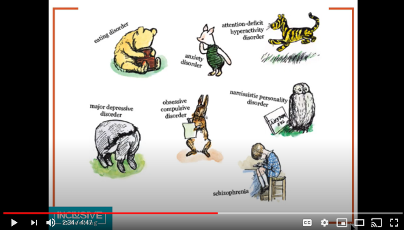
September 2019 | Length: 4:47 minsIn this video, Dr. Julie Causton founder and CEO of Inclusive Schooling, talks about how to work from a strength-based approach. And, she invites all of us to be intentional in the ways we think, write, and speak about students.
Access the PPT that is associated with this training video at via Google Docs.
Added: Jan 2021
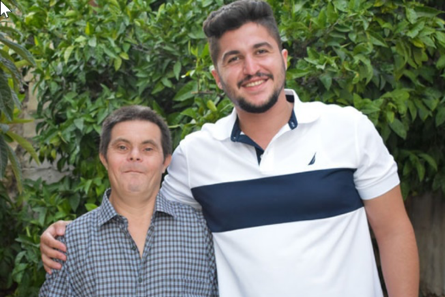 Sader Issa, who studies dentistry in Syria, shared the story of how he was raised by his dad Jad who has Down Syndrome. According to Jad’s son, his dad showered him with love and did the best that he could to make his childhood the same as any kid’s. Sader explained how his father is selfless and a real pillar of the community. Read the story and find out more about people with Down Syndrome as parents and the love of parents for their children with Down Syndrome.
Sader Issa, who studies dentistry in Syria, shared the story of how he was raised by his dad Jad who has Down Syndrome. According to Jad’s son, his dad showered him with love and did the best that he could to make his childhood the same as any kid’s. Sader explained how his father is selfless and a real pillar of the community. Read the story and find out more about people with Down Syndrome as parents and the love of parents for their children with Down Syndrome.










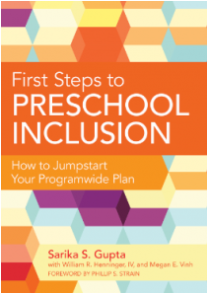 In
In 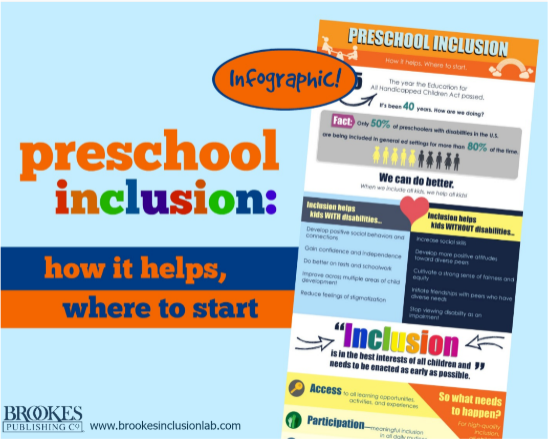 Also from First Steps to Preschool Inclusion by Sarika Gupta and her colleagues is a free chapter on
Also from First Steps to Preschool Inclusion by Sarika Gupta and her colleagues is a free chapter on 





































 When students are labeled as “too much,” the response is often exclusion. When classrooms prioritize control of students behaviours and bodies, the students exhibiting behaviours we consider “challenging” or “too much” are too often separated, segregated, secluded from the classroom community. When we prioritize control in this way, we neglect connection. We deny our students, and ourselves, the opportunity to show up as our true selves.
When students are labeled as “too much,” the response is often exclusion. When classrooms prioritize control of students behaviours and bodies, the students exhibiting behaviours we consider “challenging” or “too much” are too often separated, segregated, secluded from the classroom community. When we prioritize control in this way, we neglect connection. We deny our students, and ourselves, the opportunity to show up as our true selves.

 Kids Included Together (KIT) says, “Pinpointing exactly what it means and looks like to be inclusive can be tough because creating a sense of belonging for each child will differ from person to person and camp to camp. But, that’s really what it is – creating a sense of belonging for each camper.”
“So, where do you start and how do you know if you’ve gotten there? Well, providing a meaningful experience for every camper may look varied, but it will be rooted in a few universal principles.” This article provides helpful considerations to add to
Kids Included Together (KIT) says, “Pinpointing exactly what it means and looks like to be inclusive can be tough because creating a sense of belonging for each child will differ from person to person and camp to camp. But, that’s really what it is – creating a sense of belonging for each camper.”
“So, where do you start and how do you know if you’ve gotten there? Well, providing a meaningful experience for every camper may look varied, but it will be rooted in a few universal principles.” This article provides helpful considerations to add to 





























